The Prairie Dress: A Historical and Modern Analysis
VerifiedAdded on 2022/12/30
|25
|6950
|43
AI Summary
This dissertation explores the development and exploration of the prairie dress from the 19th century to present day. It analyzes the historical context of each period when the prairie dress became popular and examines how it has been romanticized in the 1970s and present day. The document is a BA(Hons) fashion design dissertation.
Contribute Materials
Your contribution can guide someone’s learning journey. Share your
documents today.
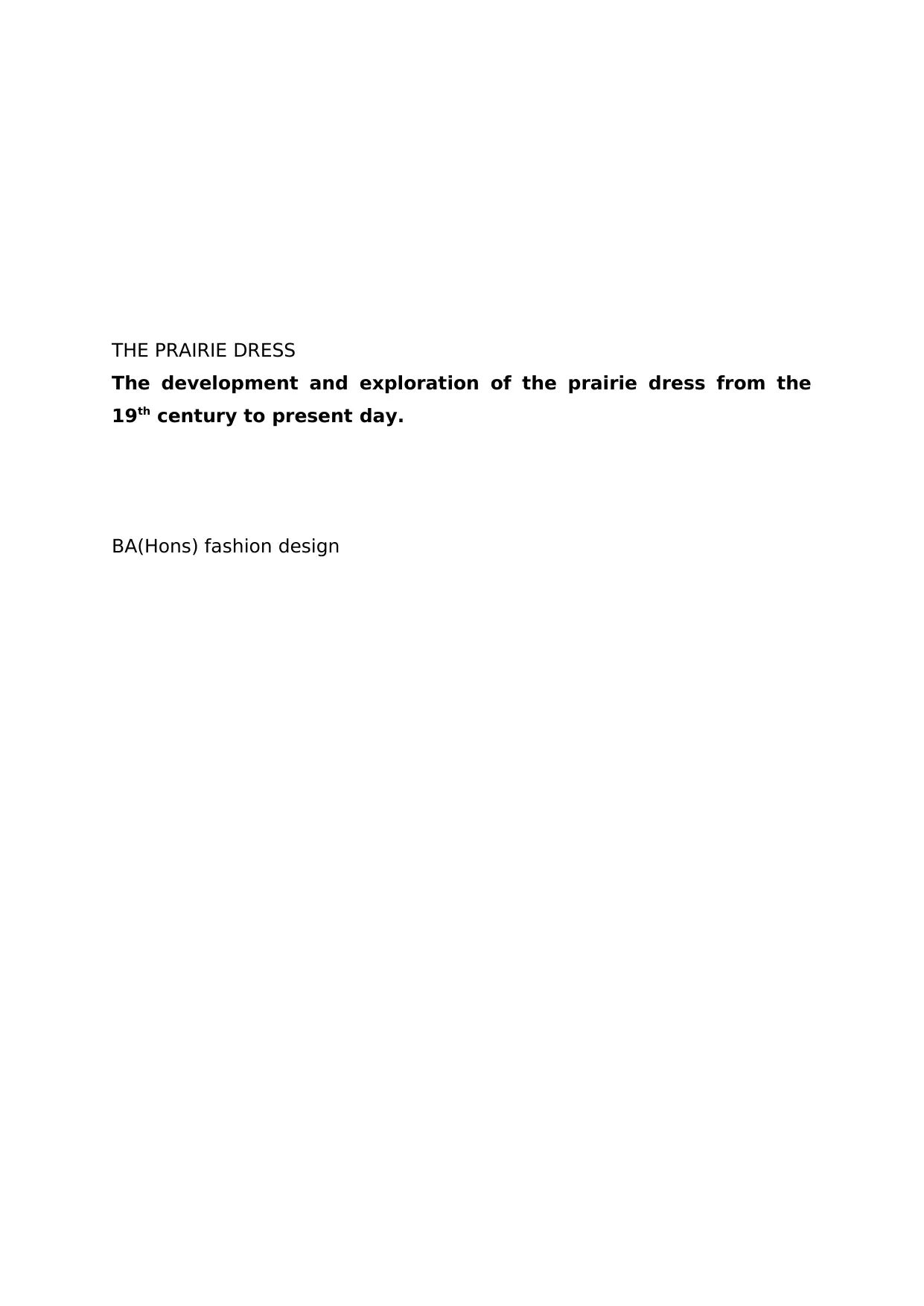
THE PRAIRIE DRESS
The development and exploration of the prairie dress from the
19th century to present day.
BA(Hons) fashion design
The development and exploration of the prairie dress from the
19th century to present day.
BA(Hons) fashion design
Secure Best Marks with AI Grader
Need help grading? Try our AI Grader for instant feedback on your assignments.
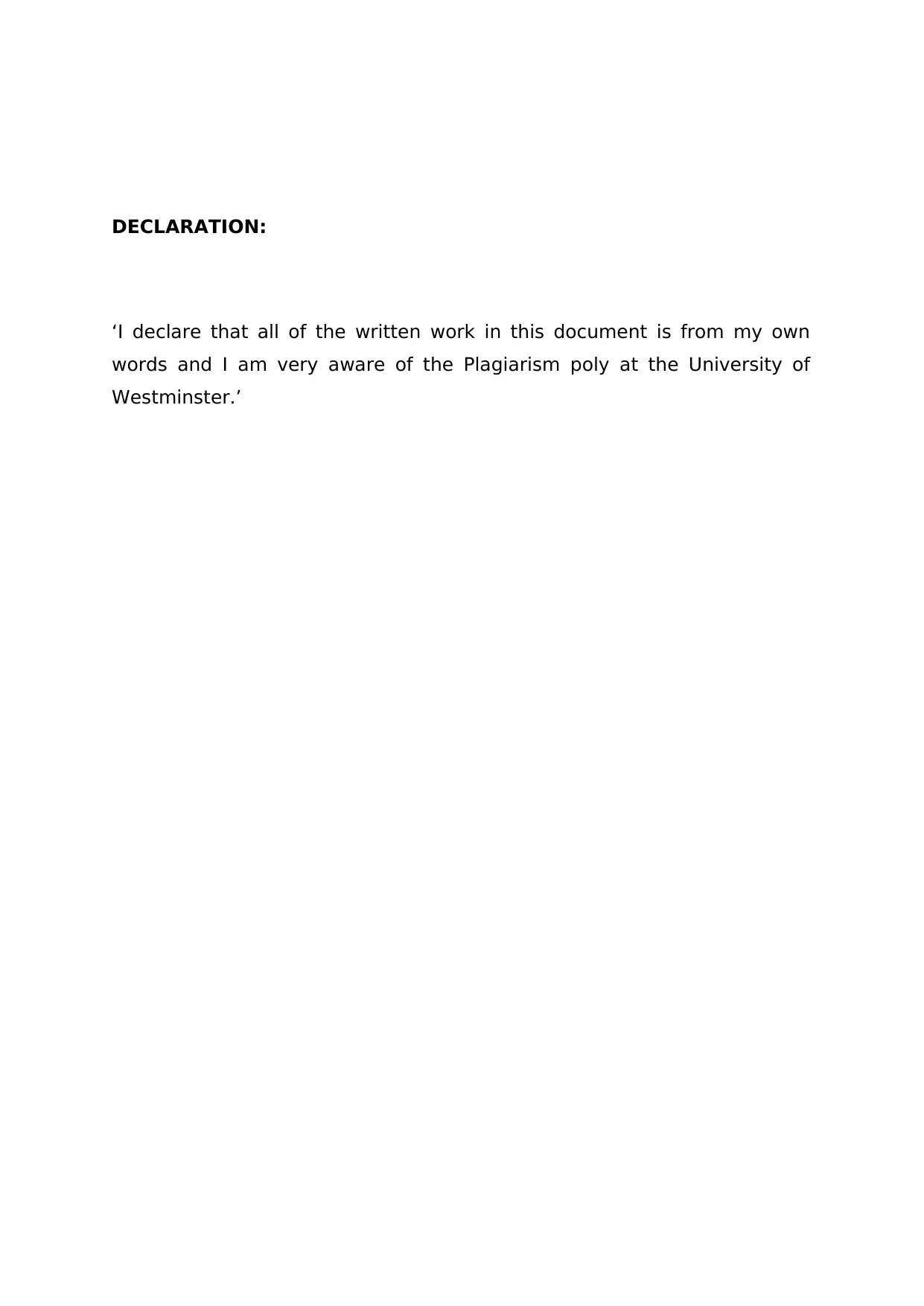
DECLARATION:
‘I declare that all of the written work in this document is from my own
words and I am very aware of the Plagiarism poly at the University of
Westminster.’
‘I declare that all of the written work in this document is from my own
words and I am very aware of the Plagiarism poly at the University of
Westminster.’
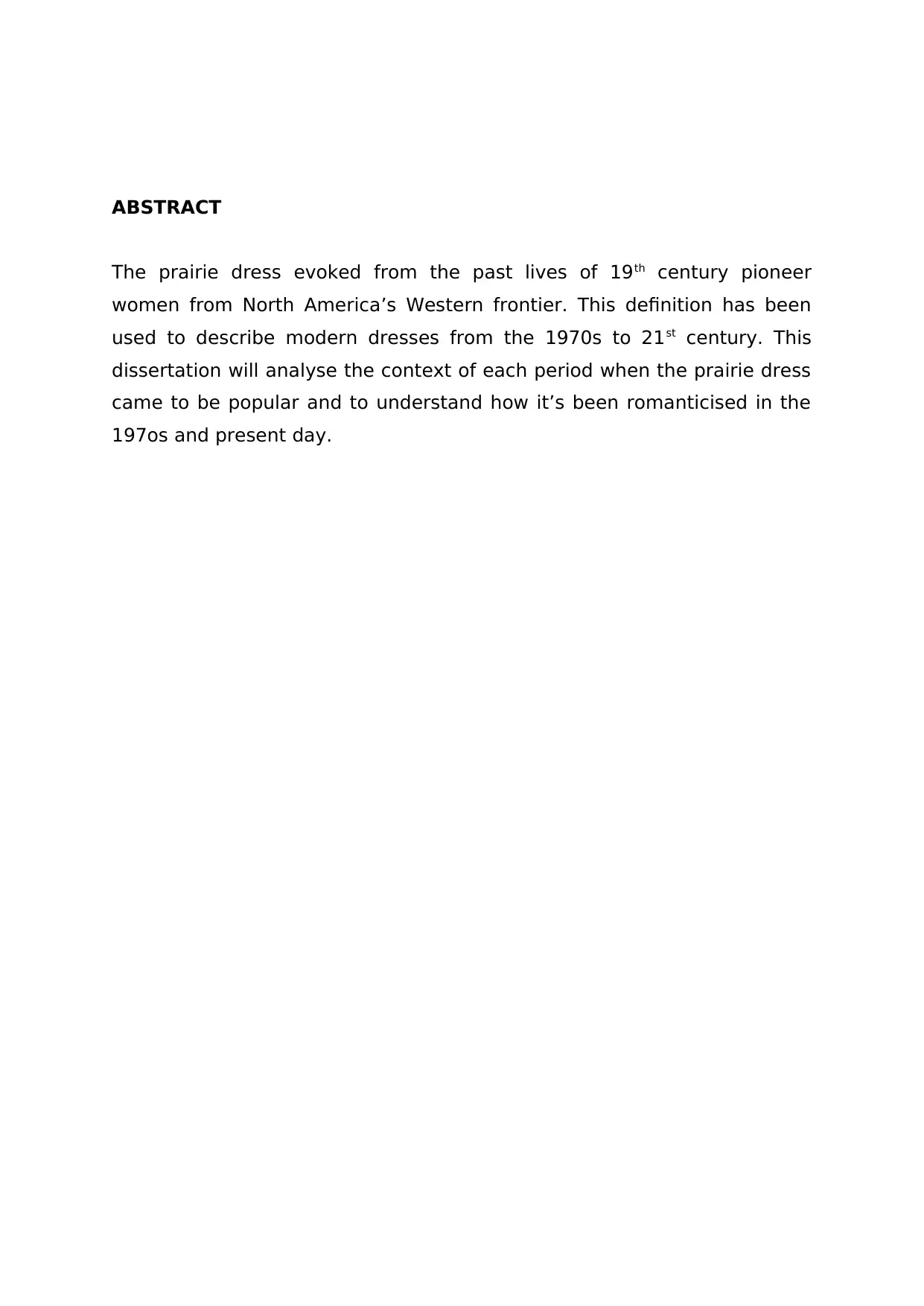
ABSTRACT
The prairie dress evoked from the past lives of 19th century pioneer
women from North America’s Western frontier. This definition has been
used to describe modern dresses from the 1970s to 21st century. This
dissertation will analyse the context of each period when the prairie dress
came to be popular and to understand how it’s been romanticised in the
197os and present day.
The prairie dress evoked from the past lives of 19th century pioneer
women from North America’s Western frontier. This definition has been
used to describe modern dresses from the 1970s to 21st century. This
dissertation will analyse the context of each period when the prairie dress
came to be popular and to understand how it’s been romanticised in the
197os and present day.
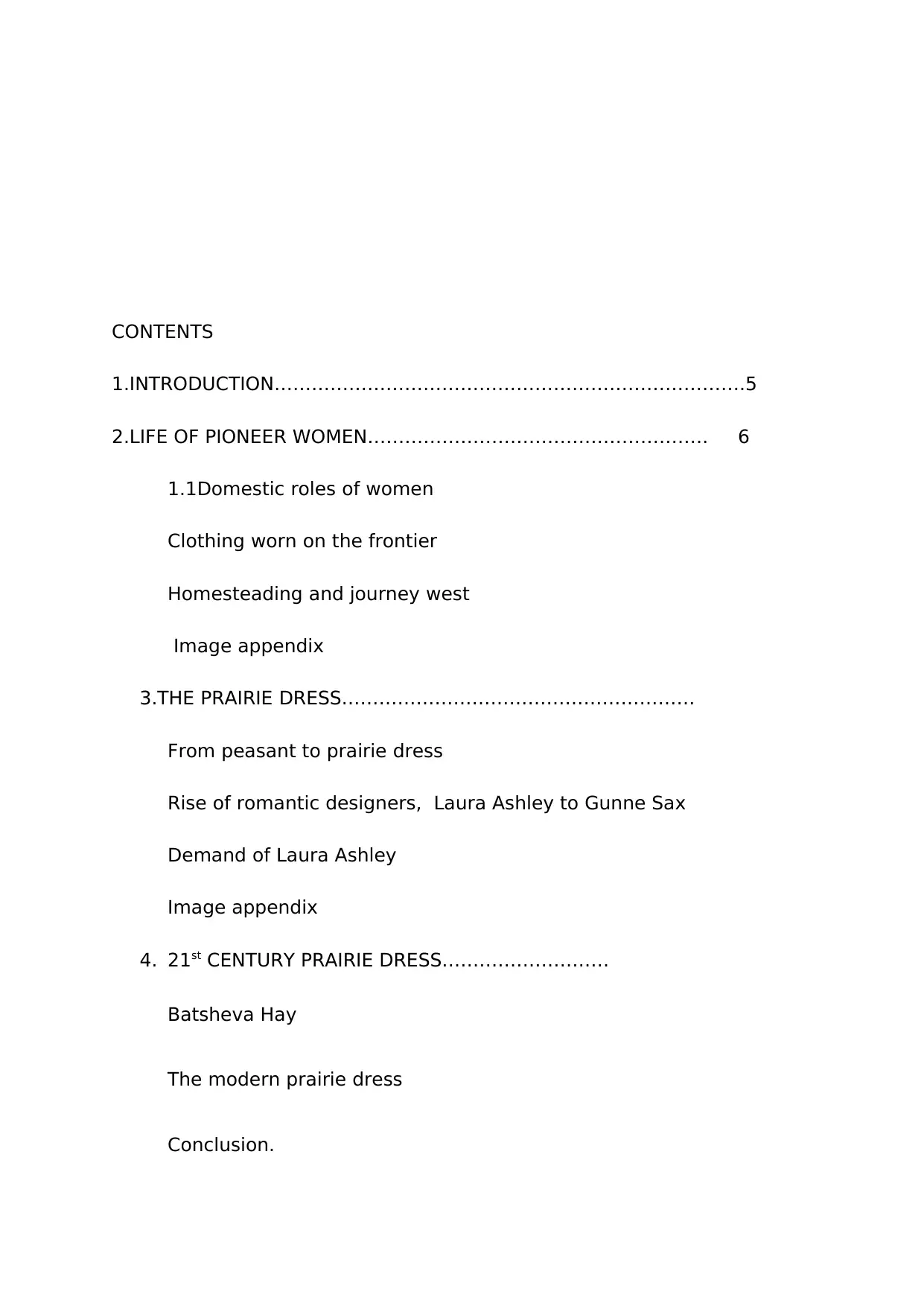
CONTENTS
1.INTRODUCTION………………………………………………………………….5
2.LIFE OF PIONEER WOMEN………………………………………………. 6
1.1Domestic roles of women
Clothing worn on the frontier
Homesteading and journey west
Image appendix
3.THE PRAIRIE DRESS…………………………………………………
From peasant to prairie dress
Rise of romantic designers, Laura Ashley to Gunne Sax
Demand of Laura Ashley
Image appendix
4. 21st CENTURY PRAIRIE DRESS………………………
Batsheva Hay
The modern prairie dress
Conclusion.
1.INTRODUCTION………………………………………………………………….5
2.LIFE OF PIONEER WOMEN………………………………………………. 6
1.1Domestic roles of women
Clothing worn on the frontier
Homesteading and journey west
Image appendix
3.THE PRAIRIE DRESS…………………………………………………
From peasant to prairie dress
Rise of romantic designers, Laura Ashley to Gunne Sax
Demand of Laura Ashley
Image appendix
4. 21st CENTURY PRAIRIE DRESS………………………
Batsheva Hay
The modern prairie dress
Conclusion.
Secure Best Marks with AI Grader
Need help grading? Try our AI Grader for instant feedback on your assignments.
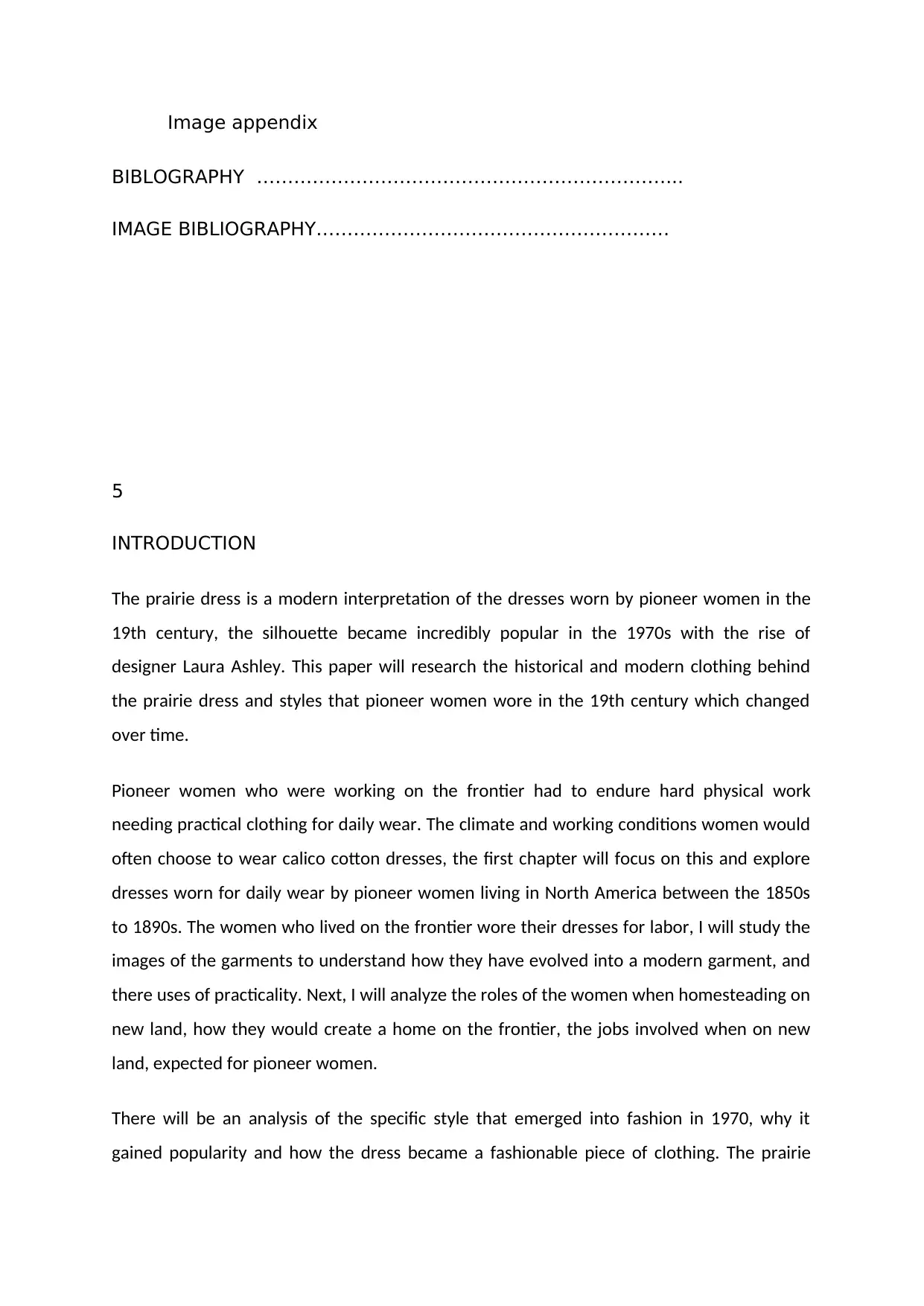
Image appendix
BIBLOGRAPHY …………………………………………………………...
IMAGE BIBLIOGRAPHY…………………………………………………
5
INTRODUCTION
The prairie dress is a modern interpretation of the dresses worn by pioneer women in the
19th century, the silhouette became incredibly popular in the 1970s with the rise of
designer Laura Ashley. This paper will research the historical and modern clothing behind
the prairie dress and styles that pioneer women wore in the 19th century which changed
over time.
Pioneer women who were working on the frontier had to endure hard physical work
needing practical clothing for daily wear. The climate and working conditions women would
often choose to wear calico cotton dresses, the first chapter will focus on this and explore
dresses worn for daily wear by pioneer women living in North America between the 1850s
to 1890s. The women who lived on the frontier wore their dresses for labor, I will study the
images of the garments to understand how they have evolved into a modern garment, and
there uses of practicality. Next, I will analyze the roles of the women when homesteading on
new land, how they would create a home on the frontier, the jobs involved when on new
land, expected for pioneer women.
There will be an analysis of the specific style that emerged into fashion in 1970, why it
gained popularity and how the dress became a fashionable piece of clothing. The prairie
BIBLOGRAPHY …………………………………………………………...
IMAGE BIBLIOGRAPHY…………………………………………………
5
INTRODUCTION
The prairie dress is a modern interpretation of the dresses worn by pioneer women in the
19th century, the silhouette became incredibly popular in the 1970s with the rise of
designer Laura Ashley. This paper will research the historical and modern clothing behind
the prairie dress and styles that pioneer women wore in the 19th century which changed
over time.
Pioneer women who were working on the frontier had to endure hard physical work
needing practical clothing for daily wear. The climate and working conditions women would
often choose to wear calico cotton dresses, the first chapter will focus on this and explore
dresses worn for daily wear by pioneer women living in North America between the 1850s
to 1890s. The women who lived on the frontier wore their dresses for labor, I will study the
images of the garments to understand how they have evolved into a modern garment, and
there uses of practicality. Next, I will analyze the roles of the women when homesteading on
new land, how they would create a home on the frontier, the jobs involved when on new
land, expected for pioneer women.
There will be an analysis of the specific style that emerged into fashion in 1970, why it
gained popularity and how the dress became a fashionable piece of clothing. The prairie
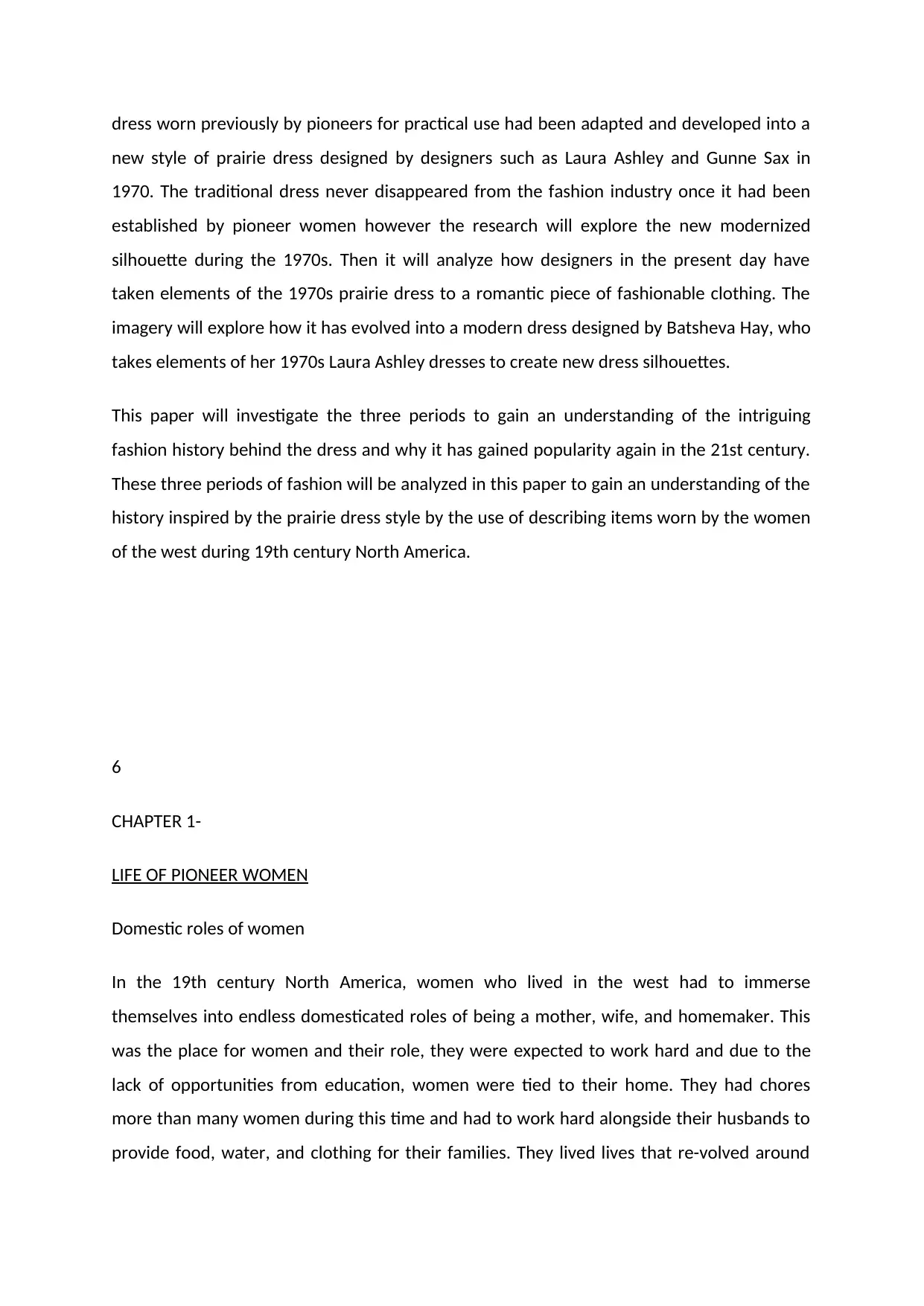
dress worn previously by pioneers for practical use had been adapted and developed into a
new style of prairie dress designed by designers such as Laura Ashley and Gunne Sax in
1970. The traditional dress never disappeared from the fashion industry once it had been
established by pioneer women however the research will explore the new modernized
silhouette during the 1970s. Then it will analyze how designers in the present day have
taken elements of the 1970s prairie dress to a romantic piece of fashionable clothing. The
imagery will explore how it has evolved into a modern dress designed by Batsheva Hay, who
takes elements of her 1970s Laura Ashley dresses to create new dress silhouettes.
This paper will investigate the three periods to gain an understanding of the intriguing
fashion history behind the dress and why it has gained popularity again in the 21st century.
These three periods of fashion will be analyzed in this paper to gain an understanding of the
history inspired by the prairie dress style by the use of describing items worn by the women
of the west during 19th century North America.
6
CHAPTER 1-
LIFE OF PIONEER WOMEN
Domestic roles of women
In the 19th century North America, women who lived in the west had to immerse
themselves into endless domesticated roles of being a mother, wife, and homemaker. This
was the place for women and their role, they were expected to work hard and due to the
lack of opportunities from education, women were tied to their home. They had chores
more than many women during this time and had to work hard alongside their husbands to
provide food, water, and clothing for their families. They lived lives that re-volved around
new style of prairie dress designed by designers such as Laura Ashley and Gunne Sax in
1970. The traditional dress never disappeared from the fashion industry once it had been
established by pioneer women however the research will explore the new modernized
silhouette during the 1970s. Then it will analyze how designers in the present day have
taken elements of the 1970s prairie dress to a romantic piece of fashionable clothing. The
imagery will explore how it has evolved into a modern dress designed by Batsheva Hay, who
takes elements of her 1970s Laura Ashley dresses to create new dress silhouettes.
This paper will investigate the three periods to gain an understanding of the intriguing
fashion history behind the dress and why it has gained popularity again in the 21st century.
These three periods of fashion will be analyzed in this paper to gain an understanding of the
history inspired by the prairie dress style by the use of describing items worn by the women
of the west during 19th century North America.
6
CHAPTER 1-
LIFE OF PIONEER WOMEN
Domestic roles of women
In the 19th century North America, women who lived in the west had to immerse
themselves into endless domesticated roles of being a mother, wife, and homemaker. This
was the place for women and their role, they were expected to work hard and due to the
lack of opportunities from education, women were tied to their home. They had chores
more than many women during this time and had to work hard alongside their husbands to
provide food, water, and clothing for their families. They lived lives that re-volved around
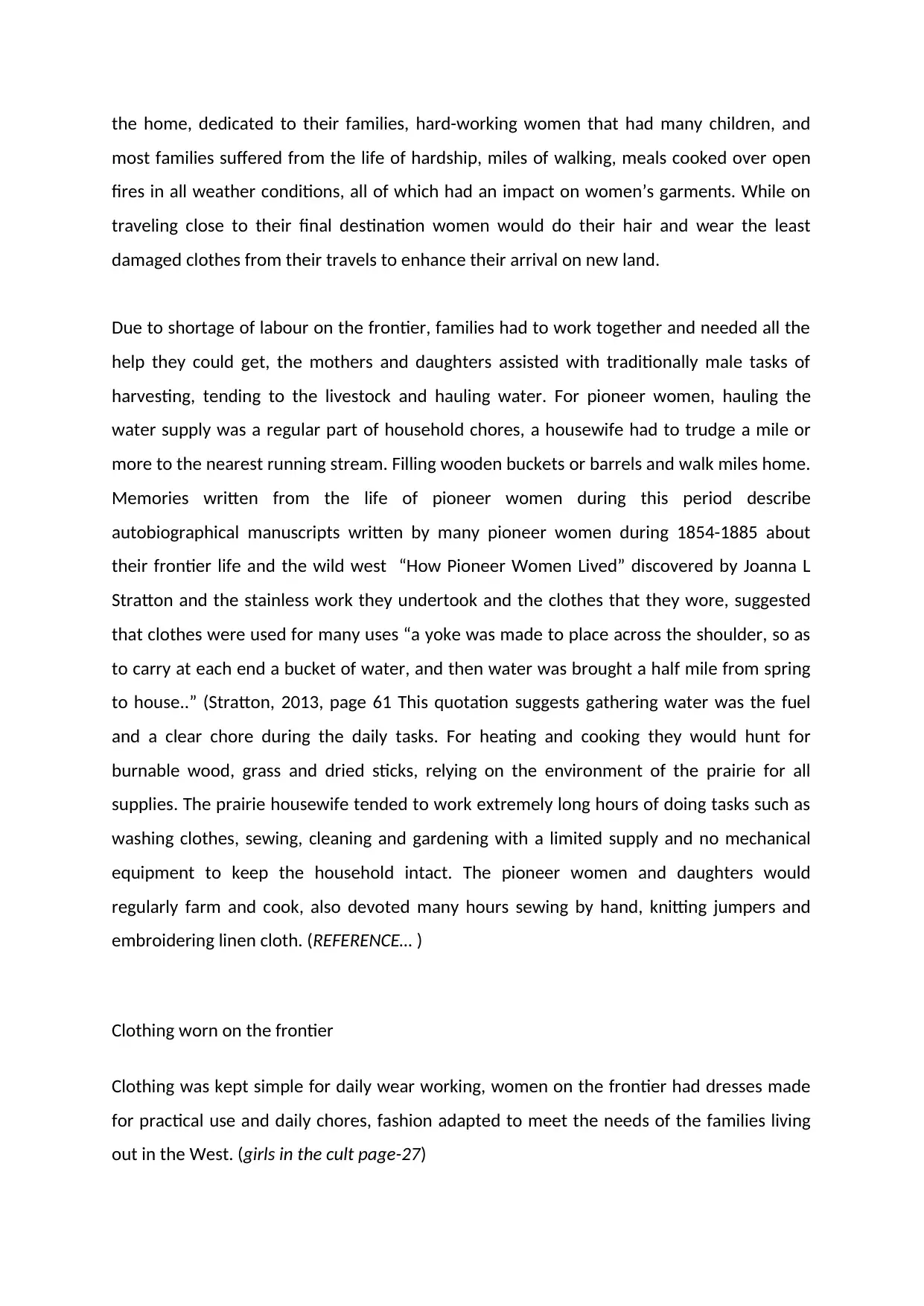
the home, dedicated to their families, hard-working women that had many children, and
most families suffered from the life of hardship, miles of walking, meals cooked over open
fires in all weather conditions, all of which had an impact on women’s garments. While on
traveling close to their final destination women would do their hair and wear the least
damaged clothes from their travels to enhance their arrival on new land.
Due to shortage of labour on the frontier, families had to work together and needed all the
help they could get, the mothers and daughters assisted with traditionally male tasks of
harvesting, tending to the livestock and hauling water. For pioneer women, hauling the
water supply was a regular part of household chores, a housewife had to trudge a mile or
more to the nearest running stream. Filling wooden buckets or barrels and walk miles home.
Memories written from the life of pioneer women during this period describe
autobiographical manuscripts written by many pioneer women during 1854-1885 about
their frontier life and the wild west “How Pioneer Women Lived” discovered by Joanna L
Stratton and the stainless work they undertook and the clothes that they wore, suggested
that clothes were used for many uses “a yoke was made to place across the shoulder, so as
to carry at each end a bucket of water, and then water was brought a half mile from spring
to house..” (Stratton, 2013, page 61 This quotation suggests gathering water was the fuel
and a clear chore during the daily tasks. For heating and cooking they would hunt for
burnable wood, grass and dried sticks, relying on the environment of the prairie for all
supplies. The prairie housewife tended to work extremely long hours of doing tasks such as
washing clothes, sewing, cleaning and gardening with a limited supply and no mechanical
equipment to keep the household intact. The pioneer women and daughters would
regularly farm and cook, also devoted many hours sewing by hand, knitting jumpers and
embroidering linen cloth. (REFERENCE… )
Clothing worn on the frontier
Clothing was kept simple for daily wear working, women on the frontier had dresses made
for practical use and daily chores, fashion adapted to meet the needs of the families living
out in the West. (girls in the cult page-27)
most families suffered from the life of hardship, miles of walking, meals cooked over open
fires in all weather conditions, all of which had an impact on women’s garments. While on
traveling close to their final destination women would do their hair and wear the least
damaged clothes from their travels to enhance their arrival on new land.
Due to shortage of labour on the frontier, families had to work together and needed all the
help they could get, the mothers and daughters assisted with traditionally male tasks of
harvesting, tending to the livestock and hauling water. For pioneer women, hauling the
water supply was a regular part of household chores, a housewife had to trudge a mile or
more to the nearest running stream. Filling wooden buckets or barrels and walk miles home.
Memories written from the life of pioneer women during this period describe
autobiographical manuscripts written by many pioneer women during 1854-1885 about
their frontier life and the wild west “How Pioneer Women Lived” discovered by Joanna L
Stratton and the stainless work they undertook and the clothes that they wore, suggested
that clothes were used for many uses “a yoke was made to place across the shoulder, so as
to carry at each end a bucket of water, and then water was brought a half mile from spring
to house..” (Stratton, 2013, page 61 This quotation suggests gathering water was the fuel
and a clear chore during the daily tasks. For heating and cooking they would hunt for
burnable wood, grass and dried sticks, relying on the environment of the prairie for all
supplies. The prairie housewife tended to work extremely long hours of doing tasks such as
washing clothes, sewing, cleaning and gardening with a limited supply and no mechanical
equipment to keep the household intact. The pioneer women and daughters would
regularly farm and cook, also devoted many hours sewing by hand, knitting jumpers and
embroidering linen cloth. (REFERENCE… )
Clothing worn on the frontier
Clothing was kept simple for daily wear working, women on the frontier had dresses made
for practical use and daily chores, fashion adapted to meet the needs of the families living
out in the West. (girls in the cult page-27)
Paraphrase This Document
Need a fresh take? Get an instant paraphrase of this document with our AI Paraphraser
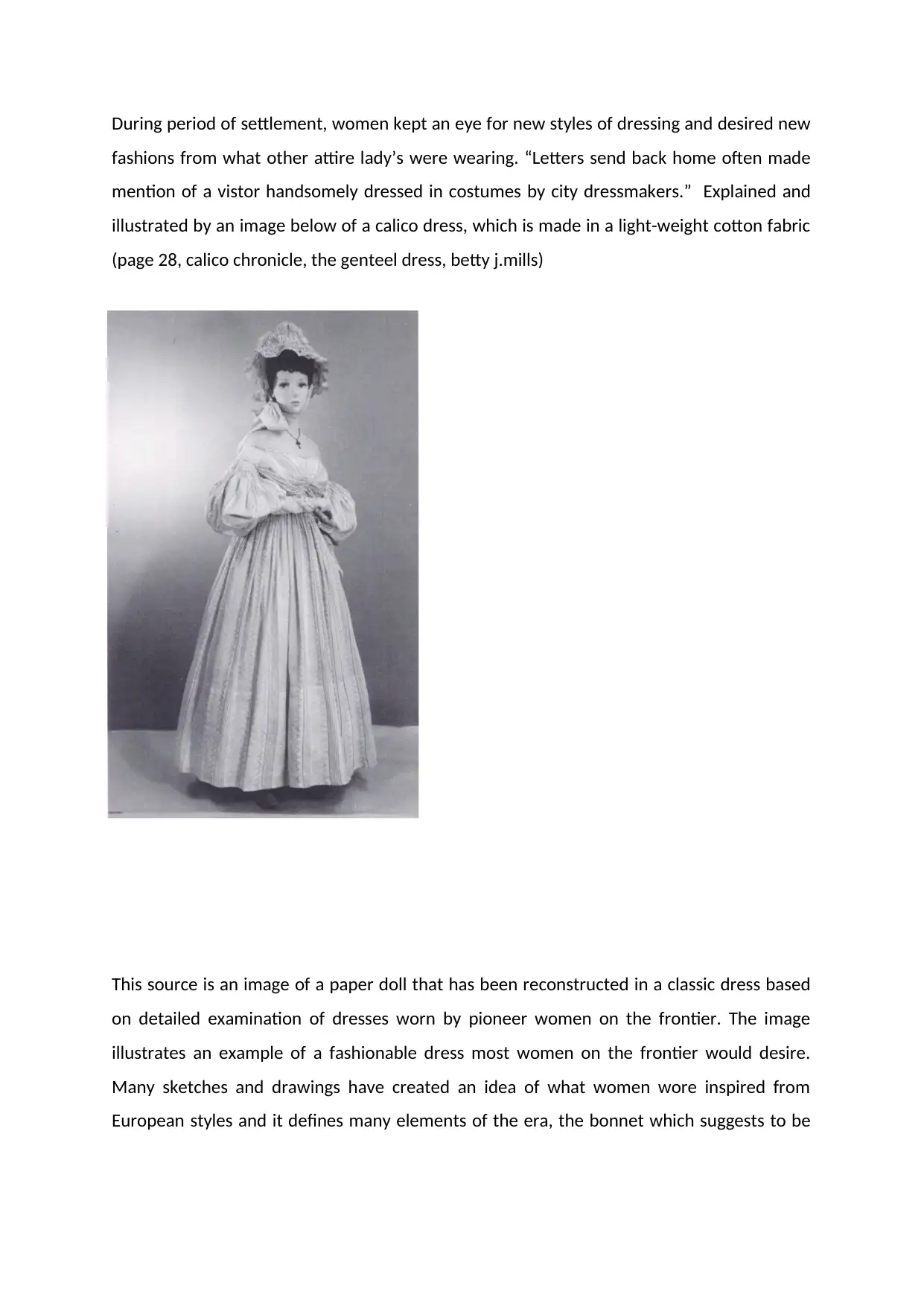
During period of settlement, women kept an eye for new styles of dressing and desired new
fashions from what other attire lady’s were wearing. “Letters send back home often made
mention of a vistor handsomely dressed in costumes by city dressmakers.” Explained and
illustrated by an image below of a calico dress, which is made in a light-weight cotton fabric
(page 28, calico chronicle, the genteel dress, betty j.mills)
This source is an image of a paper doll that has been reconstructed in a classic dress based
on detailed examination of dresses worn by pioneer women on the frontier. The image
illustrates an example of a fashionable dress most women on the frontier would desire.
Many sketches and drawings have created an idea of what women wore inspired from
European styles and it defines many elements of the era, the bonnet which suggests to be
fashions from what other attire lady’s were wearing. “Letters send back home often made
mention of a vistor handsomely dressed in costumes by city dressmakers.” Explained and
illustrated by an image below of a calico dress, which is made in a light-weight cotton fabric
(page 28, calico chronicle, the genteel dress, betty j.mills)
This source is an image of a paper doll that has been reconstructed in a classic dress based
on detailed examination of dresses worn by pioneer women on the frontier. The image
illustrates an example of a fashionable dress most women on the frontier would desire.
Many sketches and drawings have created an idea of what women wore inspired from
European styles and it defines many elements of the era, the bonnet which suggests to be

made in lace fabric, the dress in a bardot style neckline, large puff sleeves which are long in
length and gathered full skirt.
This image demonstrates a classic dress and on the frontier more of a desirable piece, this
may have been remade into a more practical garment clothing such as an apron or
children’s clothing for better use as supplies were low. “Records show that this frock was
worn by a lady in Dublin, Texas” and according to sources many elements of the dress
construction were taken from this example of earlier period frontier frock which is cited
above. The classic style of frontier dress became a garment trend of style among the
frontier, calico was an affordable fabric and many women admired stylish European dresses,
“Their style, were distinctively European” This suggests that the European style grew most
popular which retained element of the originally designed frontier dress. (PAGE 28, THE
GENTEEL DRESS, Calico chronicle, Texas women, betty j mills)
In comparison to the frontier dress, which tended to be made from home-spun calico or
muslin fabrics which was more popular style in fashion for many years on the frontier due to
practicality and material they could afford. This is demonstrated in the image below an
example of a frontier dress (calico chronicle)
The women only had a few working dresses, which were worn with a bonnet, an apron
which all were made in natural fabrics such as muslin, calico or gingham. The dress styles
were fitted bodices, sleeves were loose and held volume, mirrored by a high neck collar for
sun protection, the dresses had full skirts and due to the reality of daily tasks they tended to
be hemmed three inches shorter for practical wear and easier movement during domestic
chores. In addition to a small handful of day dresses for work and a Sunday dress, women on
the frontier would reserve a dress for socializing and important events such as weddings.
length and gathered full skirt.
This image demonstrates a classic dress and on the frontier more of a desirable piece, this
may have been remade into a more practical garment clothing such as an apron or
children’s clothing for better use as supplies were low. “Records show that this frock was
worn by a lady in Dublin, Texas” and according to sources many elements of the dress
construction were taken from this example of earlier period frontier frock which is cited
above. The classic style of frontier dress became a garment trend of style among the
frontier, calico was an affordable fabric and many women admired stylish European dresses,
“Their style, were distinctively European” This suggests that the European style grew most
popular which retained element of the originally designed frontier dress. (PAGE 28, THE
GENTEEL DRESS, Calico chronicle, Texas women, betty j mills)
In comparison to the frontier dress, which tended to be made from home-spun calico or
muslin fabrics which was more popular style in fashion for many years on the frontier due to
practicality and material they could afford. This is demonstrated in the image below an
example of a frontier dress (calico chronicle)
The women only had a few working dresses, which were worn with a bonnet, an apron
which all were made in natural fabrics such as muslin, calico or gingham. The dress styles
were fitted bodices, sleeves were loose and held volume, mirrored by a high neck collar for
sun protection, the dresses had full skirts and due to the reality of daily tasks they tended to
be hemmed three inches shorter for practical wear and easier movement during domestic
chores. In addition to a small handful of day dresses for work and a Sunday dress, women on
the frontier would reserve a dress for socializing and important events such as weddings.
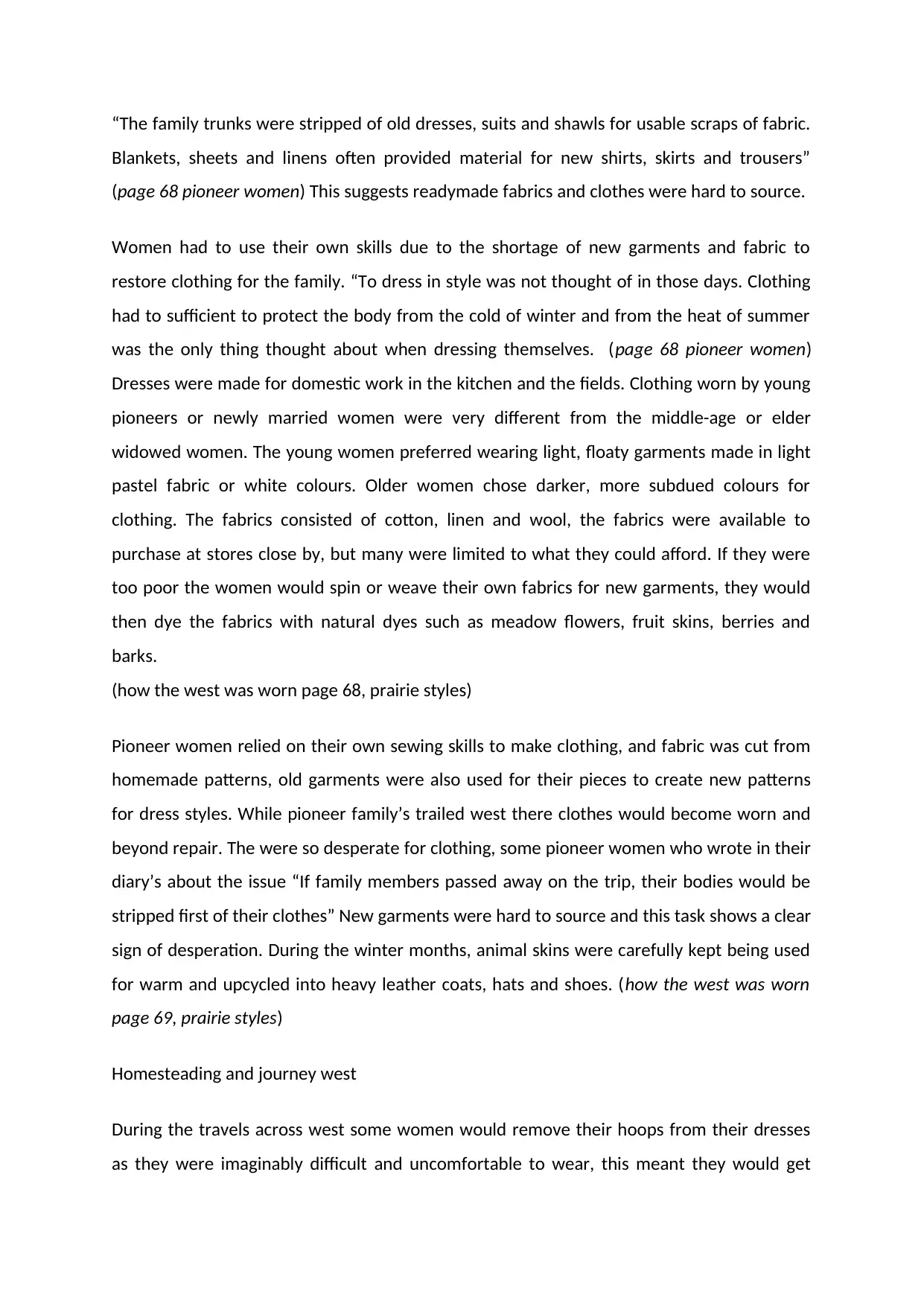
“The family trunks were stripped of old dresses, suits and shawls for usable scraps of fabric.
Blankets, sheets and linens often provided material for new shirts, skirts and trousers”
(page 68 pioneer women) This suggests readymade fabrics and clothes were hard to source.
Women had to use their own skills due to the shortage of new garments and fabric to
restore clothing for the family. “To dress in style was not thought of in those days. Clothing
had to sufficient to protect the body from the cold of winter and from the heat of summer
was the only thing thought about when dressing themselves. (page 68 pioneer women)
Dresses were made for domestic work in the kitchen and the fields. Clothing worn by young
pioneers or newly married women were very different from the middle-age or elder
widowed women. The young women preferred wearing light, floaty garments made in light
pastel fabric or white colours. Older women chose darker, more subdued colours for
clothing. The fabrics consisted of cotton, linen and wool, the fabrics were available to
purchase at stores close by, but many were limited to what they could afford. If they were
too poor the women would spin or weave their own fabrics for new garments, they would
then dye the fabrics with natural dyes such as meadow flowers, fruit skins, berries and
barks.
(how the west was worn page 68, prairie styles)
Pioneer women relied on their own sewing skills to make clothing, and fabric was cut from
homemade patterns, old garments were also used for their pieces to create new patterns
for dress styles. While pioneer family’s trailed west there clothes would become worn and
beyond repair. The were so desperate for clothing, some pioneer women who wrote in their
diary’s about the issue “If family members passed away on the trip, their bodies would be
stripped first of their clothes” New garments were hard to source and this task shows a clear
sign of desperation. During the winter months, animal skins were carefully kept being used
for warm and upcycled into heavy leather coats, hats and shoes. (how the west was worn
page 69, prairie styles)
Homesteading and journey west
During the travels across west some women would remove their hoops from their dresses
as they were imaginably difficult and uncomfortable to wear, this meant they would get
Blankets, sheets and linens often provided material for new shirts, skirts and trousers”
(page 68 pioneer women) This suggests readymade fabrics and clothes were hard to source.
Women had to use their own skills due to the shortage of new garments and fabric to
restore clothing for the family. “To dress in style was not thought of in those days. Clothing
had to sufficient to protect the body from the cold of winter and from the heat of summer
was the only thing thought about when dressing themselves. (page 68 pioneer women)
Dresses were made for domestic work in the kitchen and the fields. Clothing worn by young
pioneers or newly married women were very different from the middle-age or elder
widowed women. The young women preferred wearing light, floaty garments made in light
pastel fabric or white colours. Older women chose darker, more subdued colours for
clothing. The fabrics consisted of cotton, linen and wool, the fabrics were available to
purchase at stores close by, but many were limited to what they could afford. If they were
too poor the women would spin or weave their own fabrics for new garments, they would
then dye the fabrics with natural dyes such as meadow flowers, fruit skins, berries and
barks.
(how the west was worn page 68, prairie styles)
Pioneer women relied on their own sewing skills to make clothing, and fabric was cut from
homemade patterns, old garments were also used for their pieces to create new patterns
for dress styles. While pioneer family’s trailed west there clothes would become worn and
beyond repair. The were so desperate for clothing, some pioneer women who wrote in their
diary’s about the issue “If family members passed away on the trip, their bodies would be
stripped first of their clothes” New garments were hard to source and this task shows a clear
sign of desperation. During the winter months, animal skins were carefully kept being used
for warm and upcycled into heavy leather coats, hats and shoes. (how the west was worn
page 69, prairie styles)
Homesteading and journey west
During the travels across west some women would remove their hoops from their dresses
as they were imaginably difficult and uncomfortable to wear, this meant they would get
Secure Best Marks with AI Grader
Need help grading? Try our AI Grader for instant feedback on your assignments.
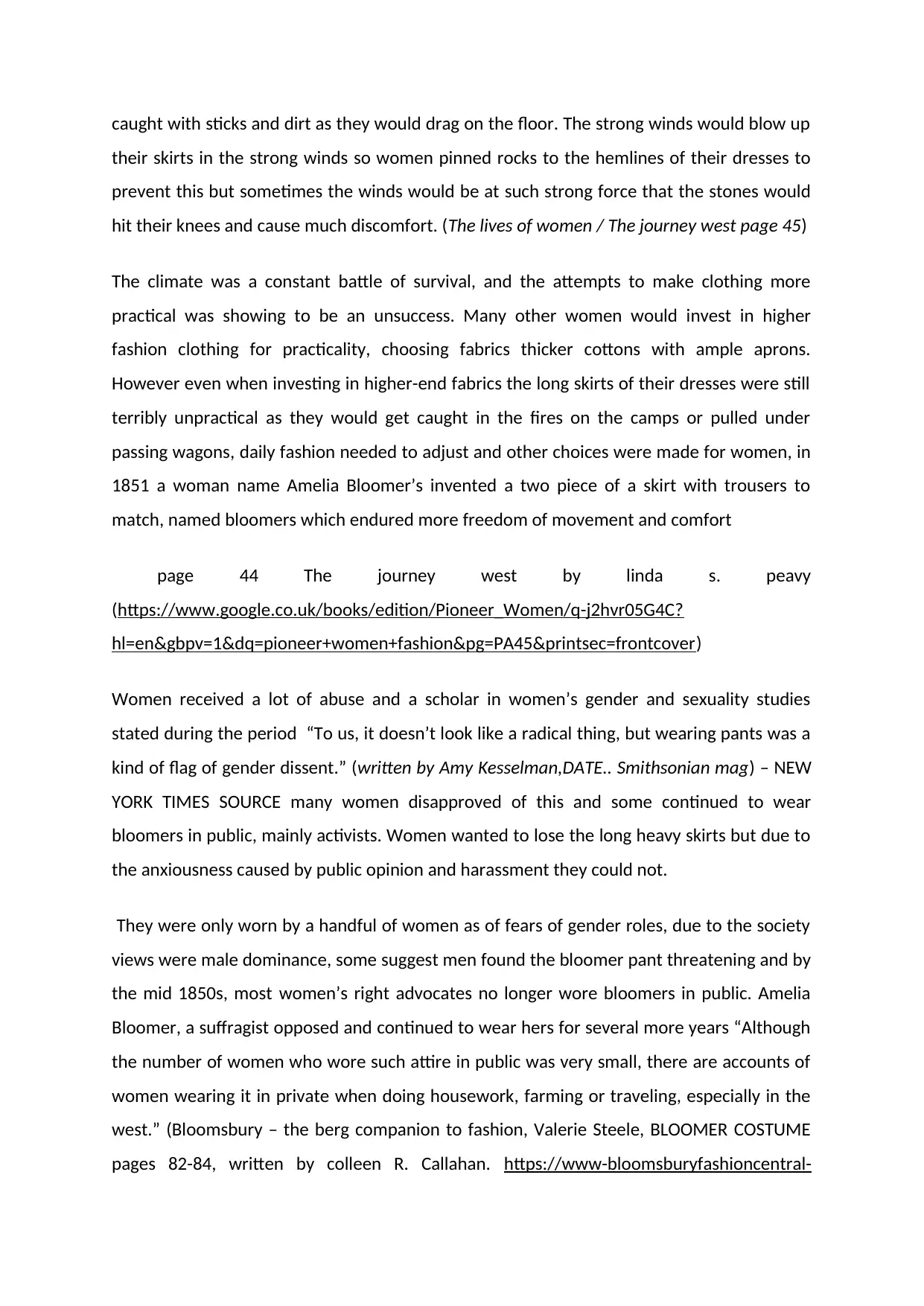
caught with sticks and dirt as they would drag on the floor. The strong winds would blow up
their skirts in the strong winds so women pinned rocks to the hemlines of their dresses to
prevent this but sometimes the winds would be at such strong force that the stones would
hit their knees and cause much discomfort. (The lives of women / The journey west page 45)
The climate was a constant battle of survival, and the attempts to make clothing more
practical was showing to be an unsuccess. Many other women would invest in higher
fashion clothing for practicality, choosing fabrics thicker cottons with ample aprons.
However even when investing in higher-end fabrics the long skirts of their dresses were still
terribly unpractical as they would get caught in the fires on the camps or pulled under
passing wagons, daily fashion needed to adjust and other choices were made for women, in
1851 a woman name Amelia Bloomer’s invented a two piece of a skirt with trousers to
match, named bloomers which endured more freedom of movement and comfort
page 44 The journey west by linda s. peavy
(https://www.google.co.uk/books/edition/Pioneer_Women/q-j2hvr05G4C?
hl=en&gbpv=1&dq=pioneer+women+fashion&pg=PA45&printsec=frontcover)
Women received a lot of abuse and a scholar in women’s gender and sexuality studies
stated during the period “To us, it doesn’t look like a radical thing, but wearing pants was a
kind of flag of gender dissent.” (written by Amy Kesselman,DATE.. Smithsonian mag) – NEW
YORK TIMES SOURCE many women disapproved of this and some continued to wear
bloomers in public, mainly activists. Women wanted to lose the long heavy skirts but due to
the anxiousness caused by public opinion and harassment they could not.
They were only worn by a handful of women as of fears of gender roles, due to the society
views were male dominance, some suggest men found the bloomer pant threatening and by
the mid 1850s, most women’s right advocates no longer wore bloomers in public. Amelia
Bloomer, a suffragist opposed and continued to wear hers for several more years “Although
the number of women who wore such attire in public was very small, there are accounts of
women wearing it in private when doing housework, farming or traveling, especially in the
west.” (Bloomsbury – the berg companion to fashion, Valerie Steele, BLOOMER COSTUME
pages 82-84, written by colleen R. Callahan. https://www-bloomsburyfashioncentral-
their skirts in the strong winds so women pinned rocks to the hemlines of their dresses to
prevent this but sometimes the winds would be at such strong force that the stones would
hit their knees and cause much discomfort. (The lives of women / The journey west page 45)
The climate was a constant battle of survival, and the attempts to make clothing more
practical was showing to be an unsuccess. Many other women would invest in higher
fashion clothing for practicality, choosing fabrics thicker cottons with ample aprons.
However even when investing in higher-end fabrics the long skirts of their dresses were still
terribly unpractical as they would get caught in the fires on the camps or pulled under
passing wagons, daily fashion needed to adjust and other choices were made for women, in
1851 a woman name Amelia Bloomer’s invented a two piece of a skirt with trousers to
match, named bloomers which endured more freedom of movement and comfort
page 44 The journey west by linda s. peavy
(https://www.google.co.uk/books/edition/Pioneer_Women/q-j2hvr05G4C?
hl=en&gbpv=1&dq=pioneer+women+fashion&pg=PA45&printsec=frontcover)
Women received a lot of abuse and a scholar in women’s gender and sexuality studies
stated during the period “To us, it doesn’t look like a radical thing, but wearing pants was a
kind of flag of gender dissent.” (written by Amy Kesselman,DATE.. Smithsonian mag) – NEW
YORK TIMES SOURCE many women disapproved of this and some continued to wear
bloomers in public, mainly activists. Women wanted to lose the long heavy skirts but due to
the anxiousness caused by public opinion and harassment they could not.
They were only worn by a handful of women as of fears of gender roles, due to the society
views were male dominance, some suggest men found the bloomer pant threatening and by
the mid 1850s, most women’s right advocates no longer wore bloomers in public. Amelia
Bloomer, a suffragist opposed and continued to wear hers for several more years “Although
the number of women who wore such attire in public was very small, there are accounts of
women wearing it in private when doing housework, farming or traveling, especially in the
west.” (Bloomsbury – the berg companion to fashion, Valerie Steele, BLOOMER COSTUME
pages 82-84, written by colleen R. Callahan. https://www-bloomsburyfashioncentral-
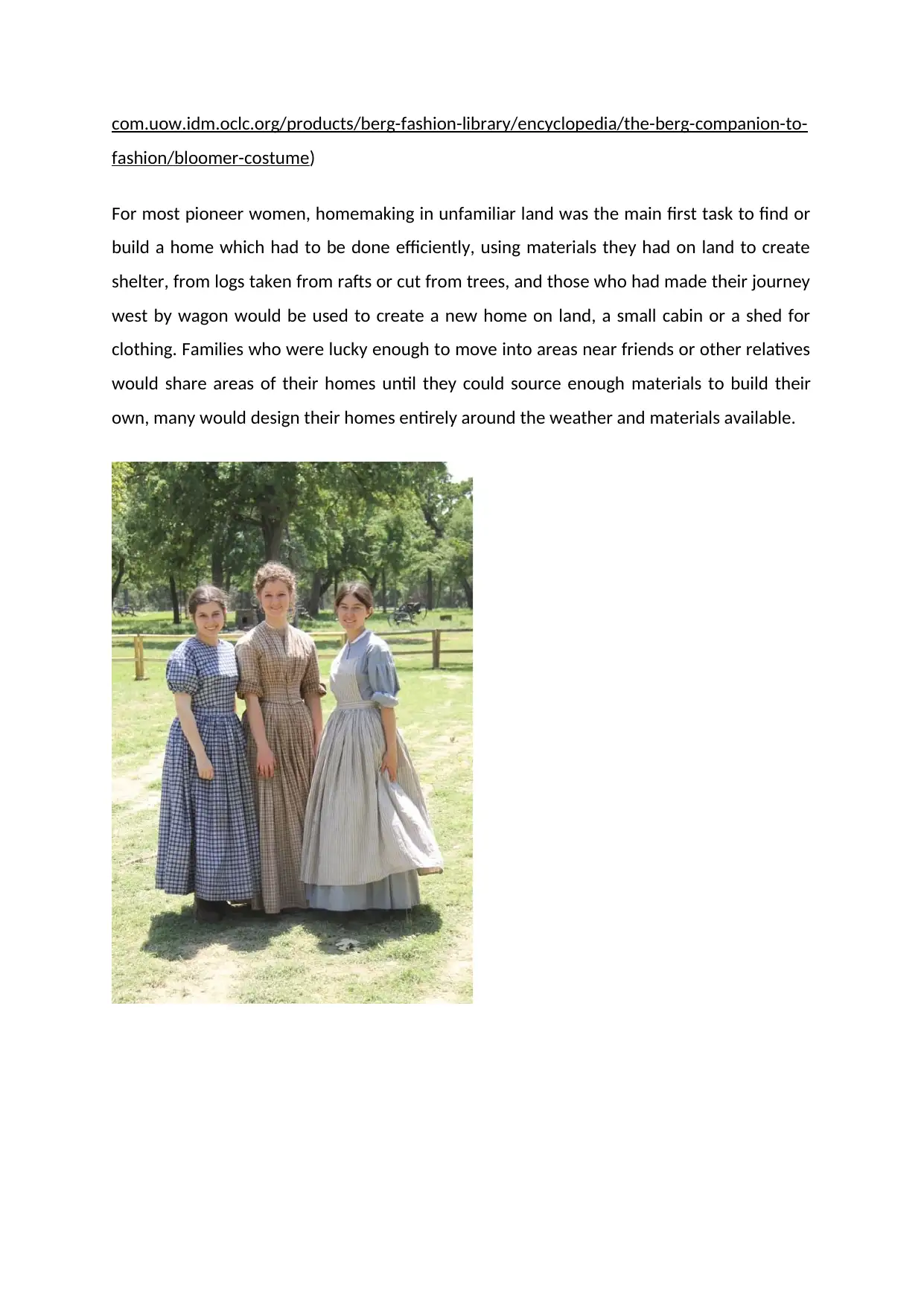
com.uow.idm.oclc.org/products/berg-fashion-library/encyclopedia/the-berg-companion-to-
fashion/bloomer-costume)
For most pioneer women, homemaking in unfamiliar land was the main first task to find or
build a home which had to be done efficiently, using materials they had on land to create
shelter, from logs taken from rafts or cut from trees, and those who had made their journey
west by wagon would be used to create a new home on land, a small cabin or a shed for
clothing. Families who were lucky enough to move into areas near friends or other relatives
would share areas of their homes until they could source enough materials to build their
own, many would design their homes entirely around the weather and materials available.
fashion/bloomer-costume)
For most pioneer women, homemaking in unfamiliar land was the main first task to find or
build a home which had to be done efficiently, using materials they had on land to create
shelter, from logs taken from rafts or cut from trees, and those who had made their journey
west by wagon would be used to create a new home on land, a small cabin or a shed for
clothing. Families who were lucky enough to move into areas near friends or other relatives
would share areas of their homes until they could source enough materials to build their
own, many would design their homes entirely around the weather and materials available.
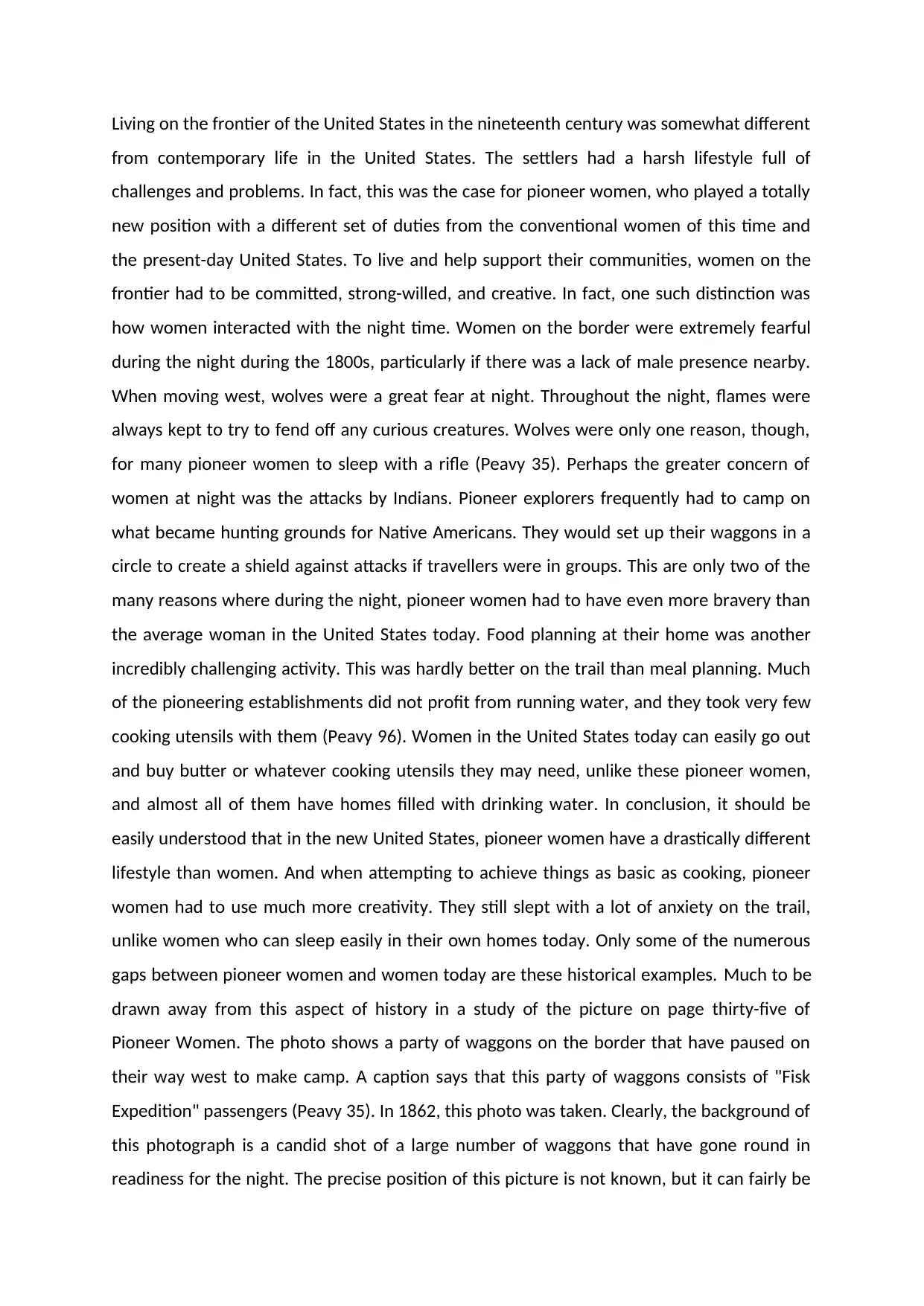
Living on the frontier of the United States in the nineteenth century was somewhat different
from contemporary life in the United States. The settlers had a harsh lifestyle full of
challenges and problems. In fact, this was the case for pioneer women, who played a totally
new position with a different set of duties from the conventional women of this time and
the present-day United States. To live and help support their communities, women on the
frontier had to be committed, strong-willed, and creative. In fact, one such distinction was
how women interacted with the night time. Women on the border were extremely fearful
during the night during the 1800s, particularly if there was a lack of male presence nearby.
When moving west, wolves were a great fear at night. Throughout the night, flames were
always kept to try to fend off any curious creatures. Wolves were only one reason, though,
for many pioneer women to sleep with a rifle (Peavy 35). Perhaps the greater concern of
women at night was the attacks by Indians. Pioneer explorers frequently had to camp on
what became hunting grounds for Native Americans. They would set up their waggons in a
circle to create a shield against attacks if travellers were in groups. This are only two of the
many reasons where during the night, pioneer women had to have even more bravery than
the average woman in the United States today. Food planning at their home was another
incredibly challenging activity. This was hardly better on the trail than meal planning. Much
of the pioneering establishments did not profit from running water, and they took very few
cooking utensils with them (Peavy 96). Women in the United States today can easily go out
and buy butter or whatever cooking utensils they may need, unlike these pioneer women,
and almost all of them have homes filled with drinking water. In conclusion, it should be
easily understood that in the new United States, pioneer women have a drastically different
lifestyle than women. And when attempting to achieve things as basic as cooking, pioneer
women had to use much more creativity. They still slept with a lot of anxiety on the trail,
unlike women who can sleep easily in their own homes today. Only some of the numerous
gaps between pioneer women and women today are these historical examples. Much to be
drawn away from this aspect of history in a study of the picture on page thirty-five of
Pioneer Women. The photo shows a party of waggons on the border that have paused on
their way west to make camp. A caption says that this party of waggons consists of "Fisk
Expedition" passengers (Peavy 35). In 1862, this photo was taken. Clearly, the background of
this photograph is a candid shot of a large number of waggons that have gone round in
readiness for the night. The precise position of this picture is not known, but it can fairly be
from contemporary life in the United States. The settlers had a harsh lifestyle full of
challenges and problems. In fact, this was the case for pioneer women, who played a totally
new position with a different set of duties from the conventional women of this time and
the present-day United States. To live and help support their communities, women on the
frontier had to be committed, strong-willed, and creative. In fact, one such distinction was
how women interacted with the night time. Women on the border were extremely fearful
during the night during the 1800s, particularly if there was a lack of male presence nearby.
When moving west, wolves were a great fear at night. Throughout the night, flames were
always kept to try to fend off any curious creatures. Wolves were only one reason, though,
for many pioneer women to sleep with a rifle (Peavy 35). Perhaps the greater concern of
women at night was the attacks by Indians. Pioneer explorers frequently had to camp on
what became hunting grounds for Native Americans. They would set up their waggons in a
circle to create a shield against attacks if travellers were in groups. This are only two of the
many reasons where during the night, pioneer women had to have even more bravery than
the average woman in the United States today. Food planning at their home was another
incredibly challenging activity. This was hardly better on the trail than meal planning. Much
of the pioneering establishments did not profit from running water, and they took very few
cooking utensils with them (Peavy 96). Women in the United States today can easily go out
and buy butter or whatever cooking utensils they may need, unlike these pioneer women,
and almost all of them have homes filled with drinking water. In conclusion, it should be
easily understood that in the new United States, pioneer women have a drastically different
lifestyle than women. And when attempting to achieve things as basic as cooking, pioneer
women had to use much more creativity. They still slept with a lot of anxiety on the trail,
unlike women who can sleep easily in their own homes today. Only some of the numerous
gaps between pioneer women and women today are these historical examples. Much to be
drawn away from this aspect of history in a study of the picture on page thirty-five of
Pioneer Women. The photo shows a party of waggons on the border that have paused on
their way west to make camp. A caption says that this party of waggons consists of "Fisk
Expedition" passengers (Peavy 35). In 1862, this photo was taken. Clearly, the background of
this photograph is a candid shot of a large number of waggons that have gone round in
readiness for the night. The precise position of this picture is not known, but it can fairly be
Paraphrase This Document
Need a fresh take? Get an instant paraphrase of this document with our AI Paraphraser
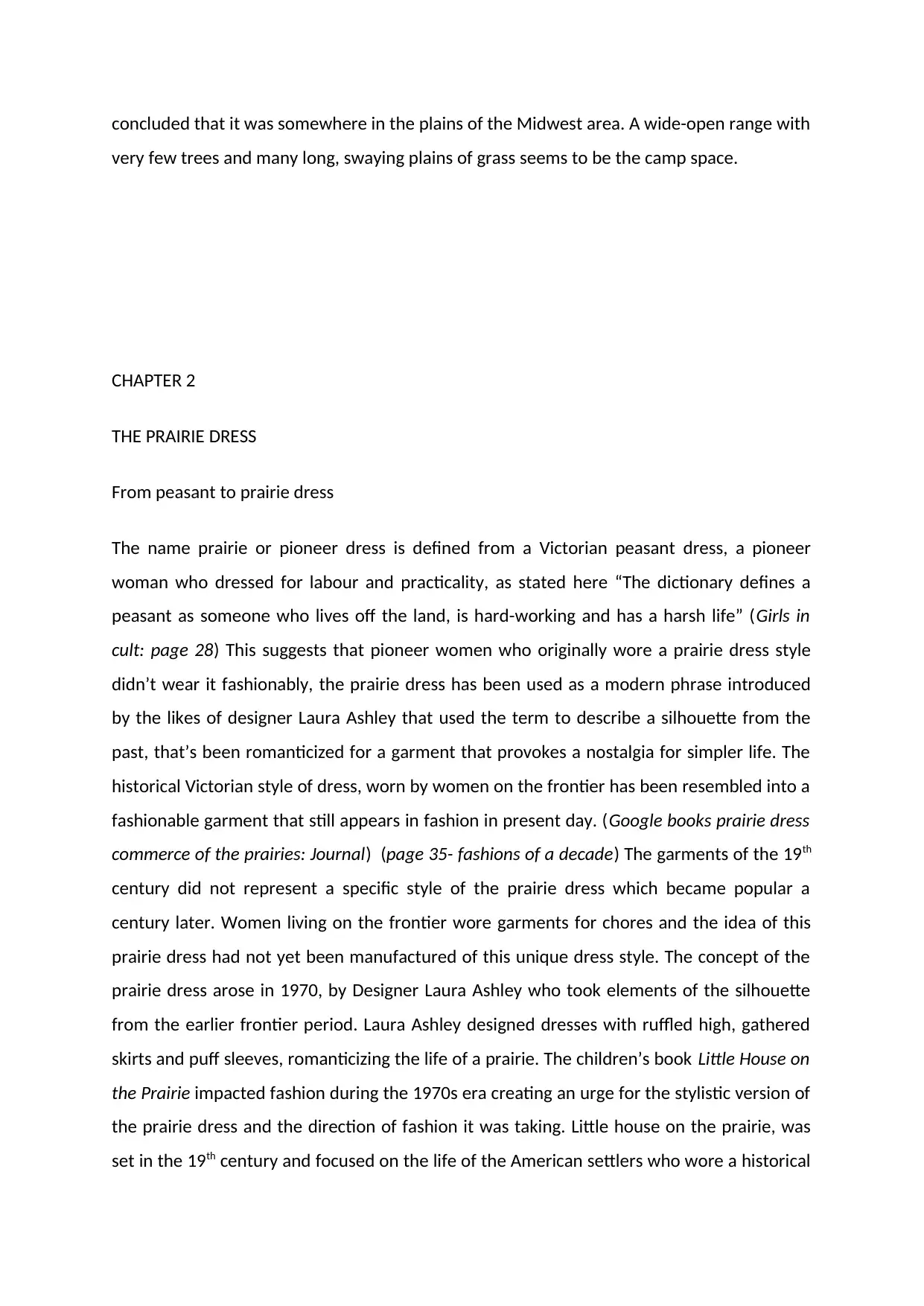
concluded that it was somewhere in the plains of the Midwest area. A wide-open range with
very few trees and many long, swaying plains of grass seems to be the camp space.
CHAPTER 2
THE PRAIRIE DRESS
From peasant to prairie dress
The name prairie or pioneer dress is defined from a Victorian peasant dress, a pioneer
woman who dressed for labour and practicality, as stated here “The dictionary defines a
peasant as someone who lives off the land, is hard-working and has a harsh life” (Girls in
cult: page 28) This suggests that pioneer women who originally wore a prairie dress style
didn’t wear it fashionably, the prairie dress has been used as a modern phrase introduced
by the likes of designer Laura Ashley that used the term to describe a silhouette from the
past, that’s been romanticized for a garment that provokes a nostalgia for simpler life. The
historical Victorian style of dress, worn by women on the frontier has been resembled into a
fashionable garment that still appears in fashion in present day. (Google books prairie dress
commerce of the prairies: Journal) (page 35- fashions of a decade) The garments of the 19th
century did not represent a specific style of the prairie dress which became popular a
century later. Women living on the frontier wore garments for chores and the idea of this
prairie dress had not yet been manufactured of this unique dress style. The concept of the
prairie dress arose in 1970, by Designer Laura Ashley who took elements of the silhouette
from the earlier frontier period. Laura Ashley designed dresses with ruffled high, gathered
skirts and puff sleeves, romanticizing the life of a prairie. The children’s book Little House on
the Prairie impacted fashion during the 1970s era creating an urge for the stylistic version of
the prairie dress and the direction of fashion it was taking. Little house on the prairie, was
set in the 19th century and focused on the life of the American settlers who wore a historical
very few trees and many long, swaying plains of grass seems to be the camp space.
CHAPTER 2
THE PRAIRIE DRESS
From peasant to prairie dress
The name prairie or pioneer dress is defined from a Victorian peasant dress, a pioneer
woman who dressed for labour and practicality, as stated here “The dictionary defines a
peasant as someone who lives off the land, is hard-working and has a harsh life” (Girls in
cult: page 28) This suggests that pioneer women who originally wore a prairie dress style
didn’t wear it fashionably, the prairie dress has been used as a modern phrase introduced
by the likes of designer Laura Ashley that used the term to describe a silhouette from the
past, that’s been romanticized for a garment that provokes a nostalgia for simpler life. The
historical Victorian style of dress, worn by women on the frontier has been resembled into a
fashionable garment that still appears in fashion in present day. (Google books prairie dress
commerce of the prairies: Journal) (page 35- fashions of a decade) The garments of the 19th
century did not represent a specific style of the prairie dress which became popular a
century later. Women living on the frontier wore garments for chores and the idea of this
prairie dress had not yet been manufactured of this unique dress style. The concept of the
prairie dress arose in 1970, by Designer Laura Ashley who took elements of the silhouette
from the earlier frontier period. Laura Ashley designed dresses with ruffled high, gathered
skirts and puff sleeves, romanticizing the life of a prairie. The children’s book Little House on
the Prairie impacted fashion during the 1970s era creating an urge for the stylistic version of
the prairie dress and the direction of fashion it was taking. Little house on the prairie, was
set in the 19th century and focused on the life of the American settlers who wore a historical
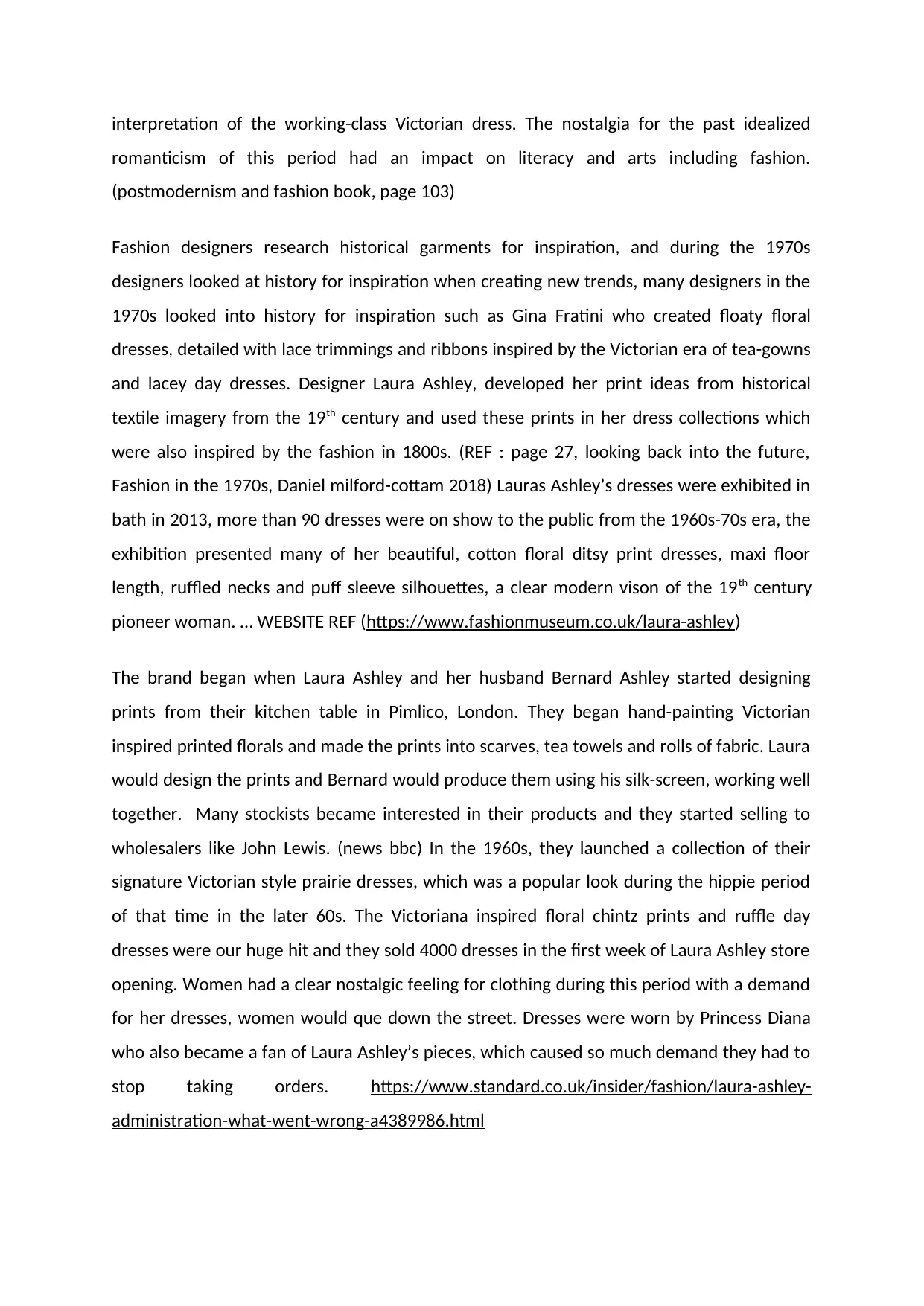
interpretation of the working-class Victorian dress. The nostalgia for the past idealized
romanticism of this period had an impact on literacy and arts including fashion.
(postmodernism and fashion book, page 103)
Fashion designers research historical garments for inspiration, and during the 1970s
designers looked at history for inspiration when creating new trends, many designers in the
1970s looked into history for inspiration such as Gina Fratini who created floaty floral
dresses, detailed with lace trimmings and ribbons inspired by the Victorian era of tea-gowns
and lacey day dresses. Designer Laura Ashley, developed her print ideas from historical
textile imagery from the 19th century and used these prints in her dress collections which
were also inspired by the fashion in 1800s. (REF : page 27, looking back into the future,
Fashion in the 1970s, Daniel milford-cottam 2018) Lauras Ashley’s dresses were exhibited in
bath in 2013, more than 90 dresses were on show to the public from the 1960s-70s era, the
exhibition presented many of her beautiful, cotton floral ditsy print dresses, maxi floor
length, ruffled necks and puff sleeve silhouettes, a clear modern vison of the 19th century
pioneer woman. … WEBSITE REF (https://www.fashionmuseum.co.uk/laura-ashley)
The brand began when Laura Ashley and her husband Bernard Ashley started designing
prints from their kitchen table in Pimlico, London. They began hand-painting Victorian
inspired printed florals and made the prints into scarves, tea towels and rolls of fabric. Laura
would design the prints and Bernard would produce them using his silk-screen, working well
together. Many stockists became interested in their products and they started selling to
wholesalers like John Lewis. (news bbc) In the 1960s, they launched a collection of their
signature Victorian style prairie dresses, which was a popular look during the hippie period
of that time in the later 60s. The Victoriana inspired floral chintz prints and ruffle day
dresses were our huge hit and they sold 4000 dresses in the first week of Laura Ashley store
opening. Women had a clear nostalgic feeling for clothing during this period with a demand
for her dresses, women would que down the street. Dresses were worn by Princess Diana
who also became a fan of Laura Ashley’s pieces, which caused so much demand they had to
stop taking orders. https://www.standard.co.uk/insider/fashion/laura-ashley-
administration-what-went-wrong-a4389986.html
romanticism of this period had an impact on literacy and arts including fashion.
(postmodernism and fashion book, page 103)
Fashion designers research historical garments for inspiration, and during the 1970s
designers looked at history for inspiration when creating new trends, many designers in the
1970s looked into history for inspiration such as Gina Fratini who created floaty floral
dresses, detailed with lace trimmings and ribbons inspired by the Victorian era of tea-gowns
and lacey day dresses. Designer Laura Ashley, developed her print ideas from historical
textile imagery from the 19th century and used these prints in her dress collections which
were also inspired by the fashion in 1800s. (REF : page 27, looking back into the future,
Fashion in the 1970s, Daniel milford-cottam 2018) Lauras Ashley’s dresses were exhibited in
bath in 2013, more than 90 dresses were on show to the public from the 1960s-70s era, the
exhibition presented many of her beautiful, cotton floral ditsy print dresses, maxi floor
length, ruffled necks and puff sleeve silhouettes, a clear modern vison of the 19th century
pioneer woman. … WEBSITE REF (https://www.fashionmuseum.co.uk/laura-ashley)
The brand began when Laura Ashley and her husband Bernard Ashley started designing
prints from their kitchen table in Pimlico, London. They began hand-painting Victorian
inspired printed florals and made the prints into scarves, tea towels and rolls of fabric. Laura
would design the prints and Bernard would produce them using his silk-screen, working well
together. Many stockists became interested in their products and they started selling to
wholesalers like John Lewis. (news bbc) In the 1960s, they launched a collection of their
signature Victorian style prairie dresses, which was a popular look during the hippie period
of that time in the later 60s. The Victoriana inspired floral chintz prints and ruffle day
dresses were our huge hit and they sold 4000 dresses in the first week of Laura Ashley store
opening. Women had a clear nostalgic feeling for clothing during this period with a demand
for her dresses, women would que down the street. Dresses were worn by Princess Diana
who also became a fan of Laura Ashley’s pieces, which caused so much demand they had to
stop taking orders. https://www.standard.co.uk/insider/fashion/laura-ashley-
administration-what-went-wrong-a4389986.html
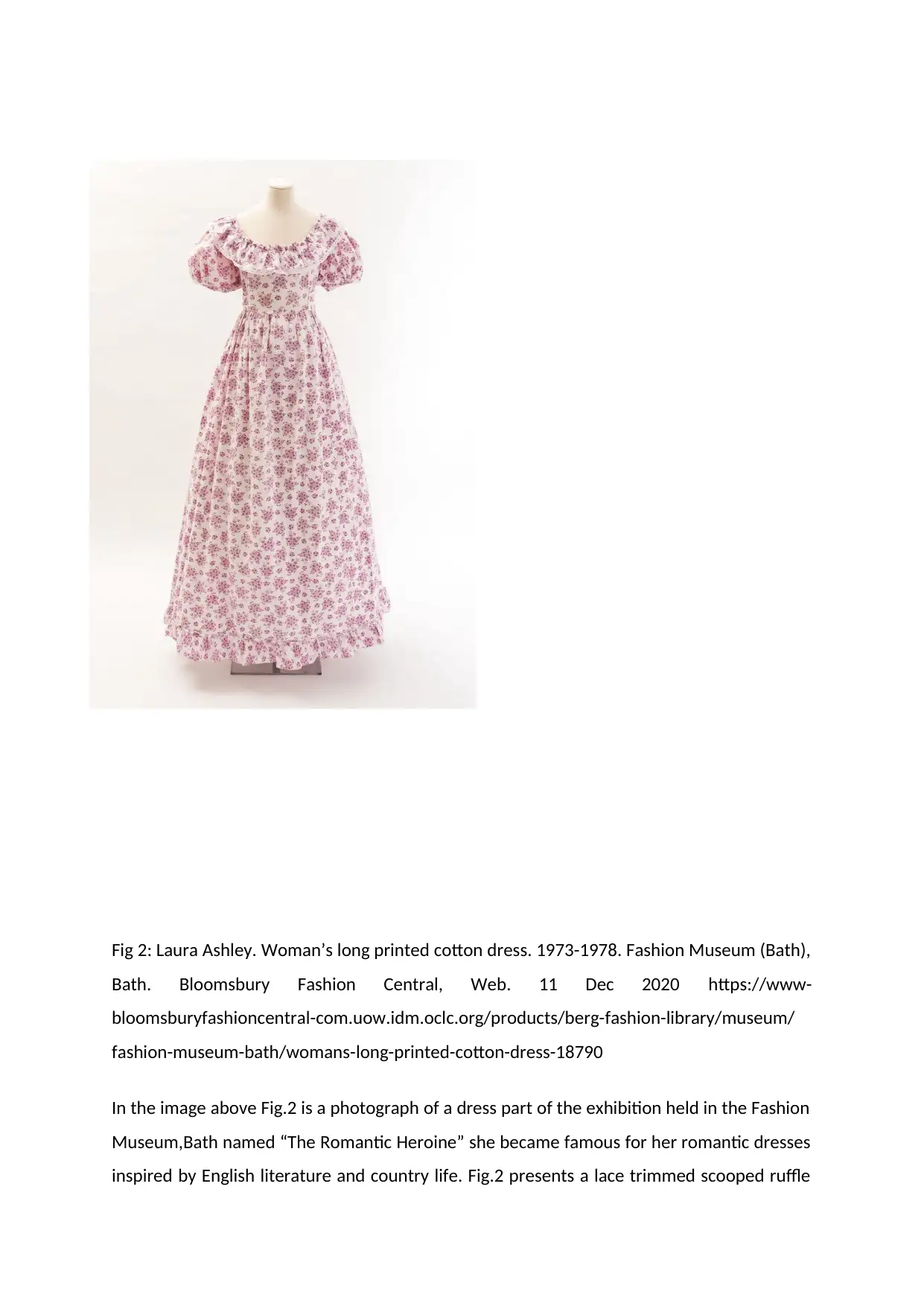
Fig 2: Laura Ashley. Woman’s long printed cotton dress. 1973-1978. Fashion Museum (Bath),
Bath. Bloomsbury Fashion Central, Web. 11 Dec 2020 https://www-
bloomsburyfashioncentral-com.uow.idm.oclc.org/products/berg-fashion-library/museum/
fashion-museum-bath/womans-long-printed-cotton-dress-18790
In the image above Fig.2 is a photograph of a dress part of the exhibition held in the Fashion
Museum,Bath named “The Romantic Heroine” she became famous for her romantic dresses
inspired by English literature and country life. Fig.2 presents a lace trimmed scooped ruffle
Bath. Bloomsbury Fashion Central, Web. 11 Dec 2020 https://www-
bloomsburyfashioncentral-com.uow.idm.oclc.org/products/berg-fashion-library/museum/
fashion-museum-bath/womans-long-printed-cotton-dress-18790
In the image above Fig.2 is a photograph of a dress part of the exhibition held in the Fashion
Museum,Bath named “The Romantic Heroine” she became famous for her romantic dresses
inspired by English literature and country life. Fig.2 presents a lace trimmed scooped ruffle
Secure Best Marks with AI Grader
Need help grading? Try our AI Grader for instant feedback on your assignments.
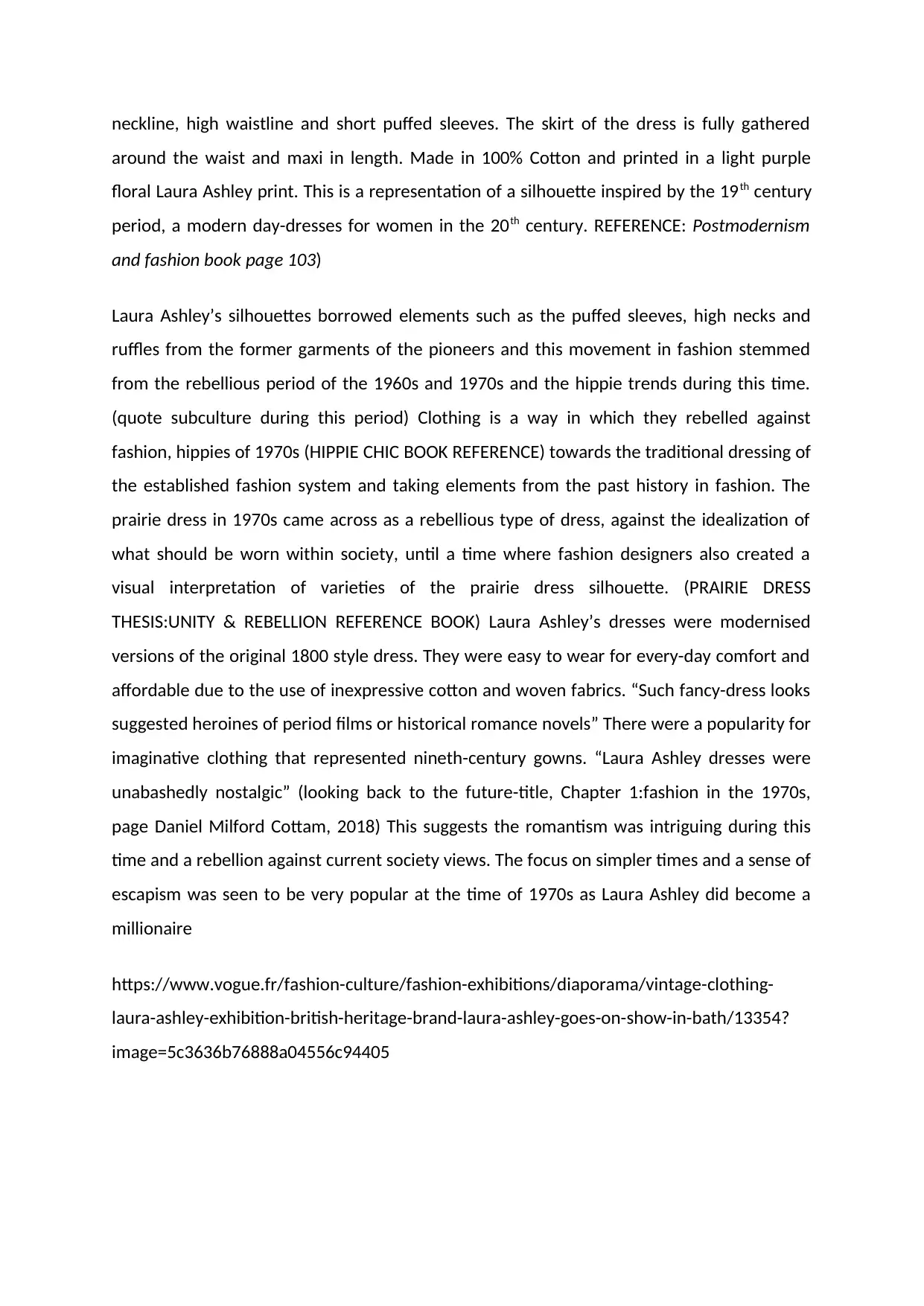
neckline, high waistline and short puffed sleeves. The skirt of the dress is fully gathered
around the waist and maxi in length. Made in 100% Cotton and printed in a light purple
floral Laura Ashley print. This is a representation of a silhouette inspired by the 19th century
period, a modern day-dresses for women in the 20th century. REFERENCE: Postmodernism
and fashion book page 103)
Laura Ashley’s silhouettes borrowed elements such as the puffed sleeves, high necks and
ruffles from the former garments of the pioneers and this movement in fashion stemmed
from the rebellious period of the 1960s and 1970s and the hippie trends during this time.
(quote subculture during this period) Clothing is a way in which they rebelled against
fashion, hippies of 1970s (HIPPIE CHIC BOOK REFERENCE) towards the traditional dressing of
the established fashion system and taking elements from the past history in fashion. The
prairie dress in 1970s came across as a rebellious type of dress, against the idealization of
what should be worn within society, until a time where fashion designers also created a
visual interpretation of varieties of the prairie dress silhouette. (PRAIRIE DRESS
THESIS:UNITY & REBELLION REFERENCE BOOK) Laura Ashley’s dresses were modernised
versions of the original 1800 style dress. They were easy to wear for every-day comfort and
affordable due to the use of inexpressive cotton and woven fabrics. “Such fancy-dress looks
suggested heroines of period films or historical romance novels” There were a popularity for
imaginative clothing that represented nineth-century gowns. “Laura Ashley dresses were
unabashedly nostalgic” (looking back to the future-title, Chapter 1:fashion in the 1970s,
page Daniel Milford Cottam, 2018) This suggests the romantism was intriguing during this
time and a rebellion against current society views. The focus on simpler times and a sense of
escapism was seen to be very popular at the time of 1970s as Laura Ashley did become a
millionaire
https://www.vogue.fr/fashion-culture/fashion-exhibitions/diaporama/vintage-clothing-
laura-ashley-exhibition-british-heritage-brand-laura-ashley-goes-on-show-in-bath/13354?
image=5c3636b76888a04556c94405
around the waist and maxi in length. Made in 100% Cotton and printed in a light purple
floral Laura Ashley print. This is a representation of a silhouette inspired by the 19th century
period, a modern day-dresses for women in the 20th century. REFERENCE: Postmodernism
and fashion book page 103)
Laura Ashley’s silhouettes borrowed elements such as the puffed sleeves, high necks and
ruffles from the former garments of the pioneers and this movement in fashion stemmed
from the rebellious period of the 1960s and 1970s and the hippie trends during this time.
(quote subculture during this period) Clothing is a way in which they rebelled against
fashion, hippies of 1970s (HIPPIE CHIC BOOK REFERENCE) towards the traditional dressing of
the established fashion system and taking elements from the past history in fashion. The
prairie dress in 1970s came across as a rebellious type of dress, against the idealization of
what should be worn within society, until a time where fashion designers also created a
visual interpretation of varieties of the prairie dress silhouette. (PRAIRIE DRESS
THESIS:UNITY & REBELLION REFERENCE BOOK) Laura Ashley’s dresses were modernised
versions of the original 1800 style dress. They were easy to wear for every-day comfort and
affordable due to the use of inexpressive cotton and woven fabrics. “Such fancy-dress looks
suggested heroines of period films or historical romance novels” There were a popularity for
imaginative clothing that represented nineth-century gowns. “Laura Ashley dresses were
unabashedly nostalgic” (looking back to the future-title, Chapter 1:fashion in the 1970s,
page Daniel Milford Cottam, 2018) This suggests the romantism was intriguing during this
time and a rebellion against current society views. The focus on simpler times and a sense of
escapism was seen to be very popular at the time of 1970s as Laura Ashley did become a
millionaire
https://www.vogue.fr/fashion-culture/fashion-exhibitions/diaporama/vintage-clothing-
laura-ashley-exhibition-british-heritage-brand-laura-ashley-goes-on-show-in-bath/13354?
image=5c3636b76888a04556c94405
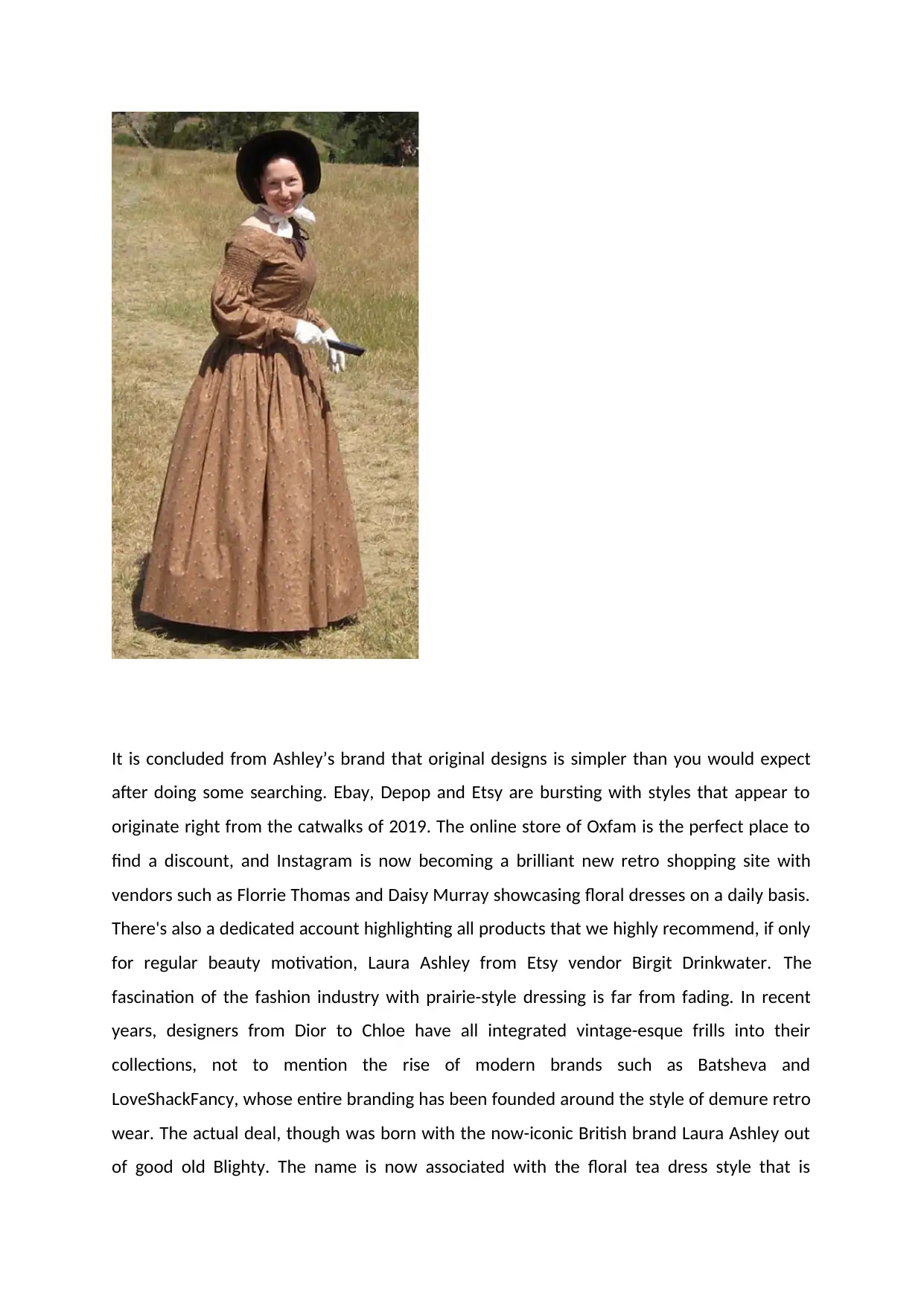
It is concluded from Ashley’s brand that original designs is simpler than you would expect
after doing some searching. Ebay, Depop and Etsy are bursting with styles that appear to
originate right from the catwalks of 2019. The online store of Oxfam is the perfect place to
find a discount, and Instagram is now becoming a brilliant new retro shopping site with
vendors such as Florrie Thomas and Daisy Murray showcasing floral dresses on a daily basis.
There's also a dedicated account highlighting all products that we highly recommend, if only
for regular beauty motivation, Laura Ashley from Etsy vendor Birgit Drinkwater. The
fascination of the fashion industry with prairie-style dressing is far from fading. In recent
years, designers from Dior to Chloe have all integrated vintage-esque frills into their
collections, not to mention the rise of modern brands such as Batsheva and
LoveShackFancy, whose entire branding has been founded around the style of demure retro
wear. The actual deal, though was born with the now-iconic British brand Laura Ashley out
of good old Blighty. The name is now associated with the floral tea dress style that is
after doing some searching. Ebay, Depop and Etsy are bursting with styles that appear to
originate right from the catwalks of 2019. The online store of Oxfam is the perfect place to
find a discount, and Instagram is now becoming a brilliant new retro shopping site with
vendors such as Florrie Thomas and Daisy Murray showcasing floral dresses on a daily basis.
There's also a dedicated account highlighting all products that we highly recommend, if only
for regular beauty motivation, Laura Ashley from Etsy vendor Birgit Drinkwater. The
fascination of the fashion industry with prairie-style dressing is far from fading. In recent
years, designers from Dior to Chloe have all integrated vintage-esque frills into their
collections, not to mention the rise of modern brands such as Batsheva and
LoveShackFancy, whose entire branding has been founded around the style of demure retro
wear. The actual deal, though was born with the now-iconic British brand Laura Ashley out
of good old Blighty. The name is now associated with the floral tea dress style that is
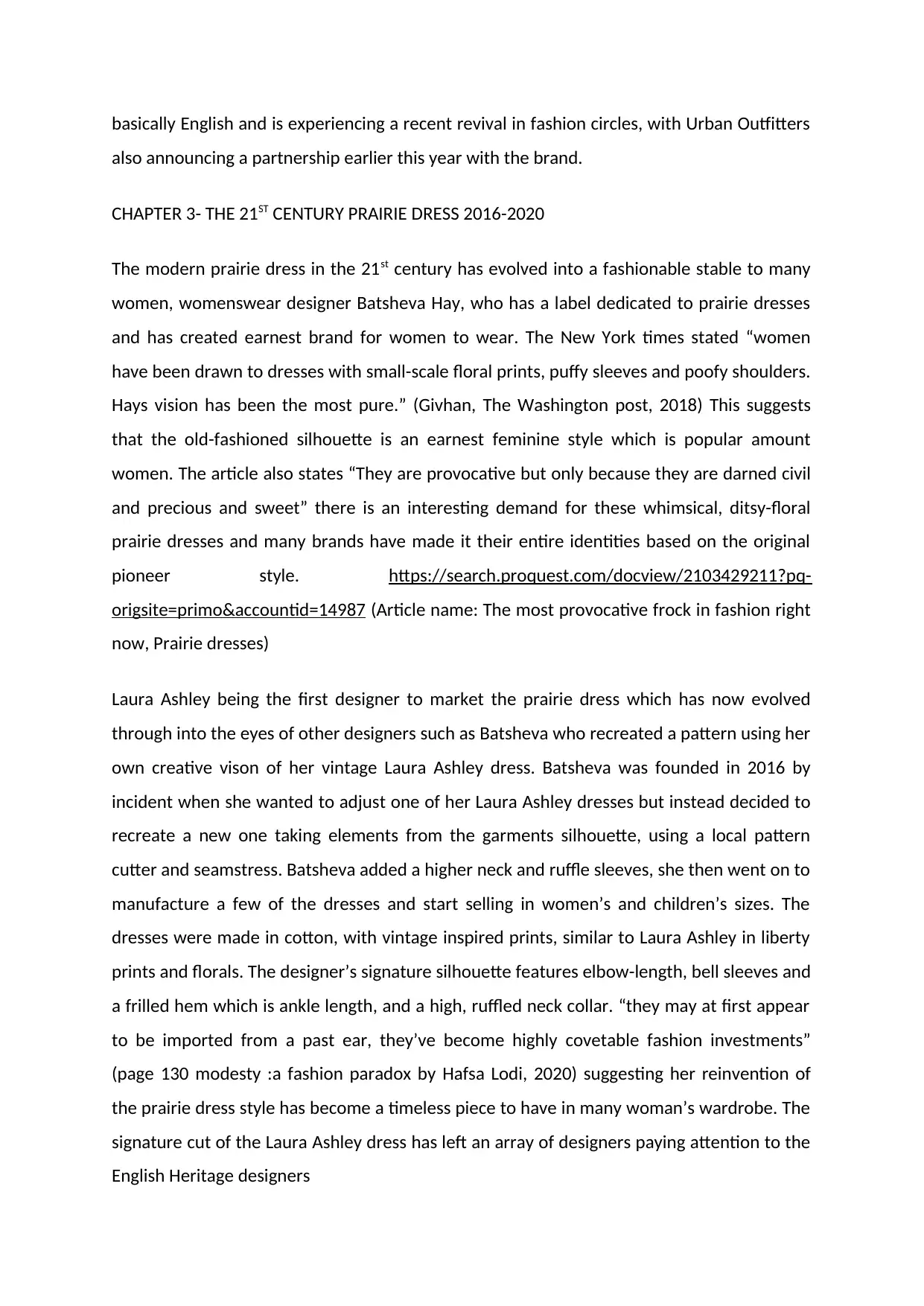
basically English and is experiencing a recent revival in fashion circles, with Urban Outfitters
also announcing a partnership earlier this year with the brand.
CHAPTER 3- THE 21ST CENTURY PRAIRIE DRESS 2016-2020
The modern prairie dress in the 21st century has evolved into a fashionable stable to many
women, womenswear designer Batsheva Hay, who has a label dedicated to prairie dresses
and has created earnest brand for women to wear. The New York times stated “women
have been drawn to dresses with small-scale floral prints, puffy sleeves and poofy shoulders.
Hays vision has been the most pure.” (Givhan, The Washington post, 2018) This suggests
that the old-fashioned silhouette is an earnest feminine style which is popular amount
women. The article also states “They are provocative but only because they are darned civil
and precious and sweet” there is an interesting demand for these whimsical, ditsy-floral
prairie dresses and many brands have made it their entire identities based on the original
pioneer style. https://search.proquest.com/docview/2103429211?pq-
origsite=primo&accountid=14987 (Article name: The most provocative frock in fashion right
now, Prairie dresses)
Laura Ashley being the first designer to market the prairie dress which has now evolved
through into the eyes of other designers such as Batsheva who recreated a pattern using her
own creative vison of her vintage Laura Ashley dress. Batsheva was founded in 2016 by
incident when she wanted to adjust one of her Laura Ashley dresses but instead decided to
recreate a new one taking elements from the garments silhouette, using a local pattern
cutter and seamstress. Batsheva added a higher neck and ruffle sleeves, she then went on to
manufacture a few of the dresses and start selling in women’s and children’s sizes. The
dresses were made in cotton, with vintage inspired prints, similar to Laura Ashley in liberty
prints and florals. The designer’s signature silhouette features elbow-length, bell sleeves and
a frilled hem which is ankle length, and a high, ruffled neck collar. “they may at first appear
to be imported from a past ear, they’ve become highly covetable fashion investments”
(page 130 modesty :a fashion paradox by Hafsa Lodi, 2020) suggesting her reinvention of
the prairie dress style has become a timeless piece to have in many woman’s wardrobe. The
signature cut of the Laura Ashley dress has left an array of designers paying attention to the
English Heritage designers
also announcing a partnership earlier this year with the brand.
CHAPTER 3- THE 21ST CENTURY PRAIRIE DRESS 2016-2020
The modern prairie dress in the 21st century has evolved into a fashionable stable to many
women, womenswear designer Batsheva Hay, who has a label dedicated to prairie dresses
and has created earnest brand for women to wear. The New York times stated “women
have been drawn to dresses with small-scale floral prints, puffy sleeves and poofy shoulders.
Hays vision has been the most pure.” (Givhan, The Washington post, 2018) This suggests
that the old-fashioned silhouette is an earnest feminine style which is popular amount
women. The article also states “They are provocative but only because they are darned civil
and precious and sweet” there is an interesting demand for these whimsical, ditsy-floral
prairie dresses and many brands have made it their entire identities based on the original
pioneer style. https://search.proquest.com/docview/2103429211?pq-
origsite=primo&accountid=14987 (Article name: The most provocative frock in fashion right
now, Prairie dresses)
Laura Ashley being the first designer to market the prairie dress which has now evolved
through into the eyes of other designers such as Batsheva who recreated a pattern using her
own creative vison of her vintage Laura Ashley dress. Batsheva was founded in 2016 by
incident when she wanted to adjust one of her Laura Ashley dresses but instead decided to
recreate a new one taking elements from the garments silhouette, using a local pattern
cutter and seamstress. Batsheva added a higher neck and ruffle sleeves, she then went on to
manufacture a few of the dresses and start selling in women’s and children’s sizes. The
dresses were made in cotton, with vintage inspired prints, similar to Laura Ashley in liberty
prints and florals. The designer’s signature silhouette features elbow-length, bell sleeves and
a frilled hem which is ankle length, and a high, ruffled neck collar. “they may at first appear
to be imported from a past ear, they’ve become highly covetable fashion investments”
(page 130 modesty :a fashion paradox by Hafsa Lodi, 2020) suggesting her reinvention of
the prairie dress style has become a timeless piece to have in many woman’s wardrobe. The
signature cut of the Laura Ashley dress has left an array of designers paying attention to the
English Heritage designers
Paraphrase This Document
Need a fresh take? Get an instant paraphrase of this document with our AI Paraphraser
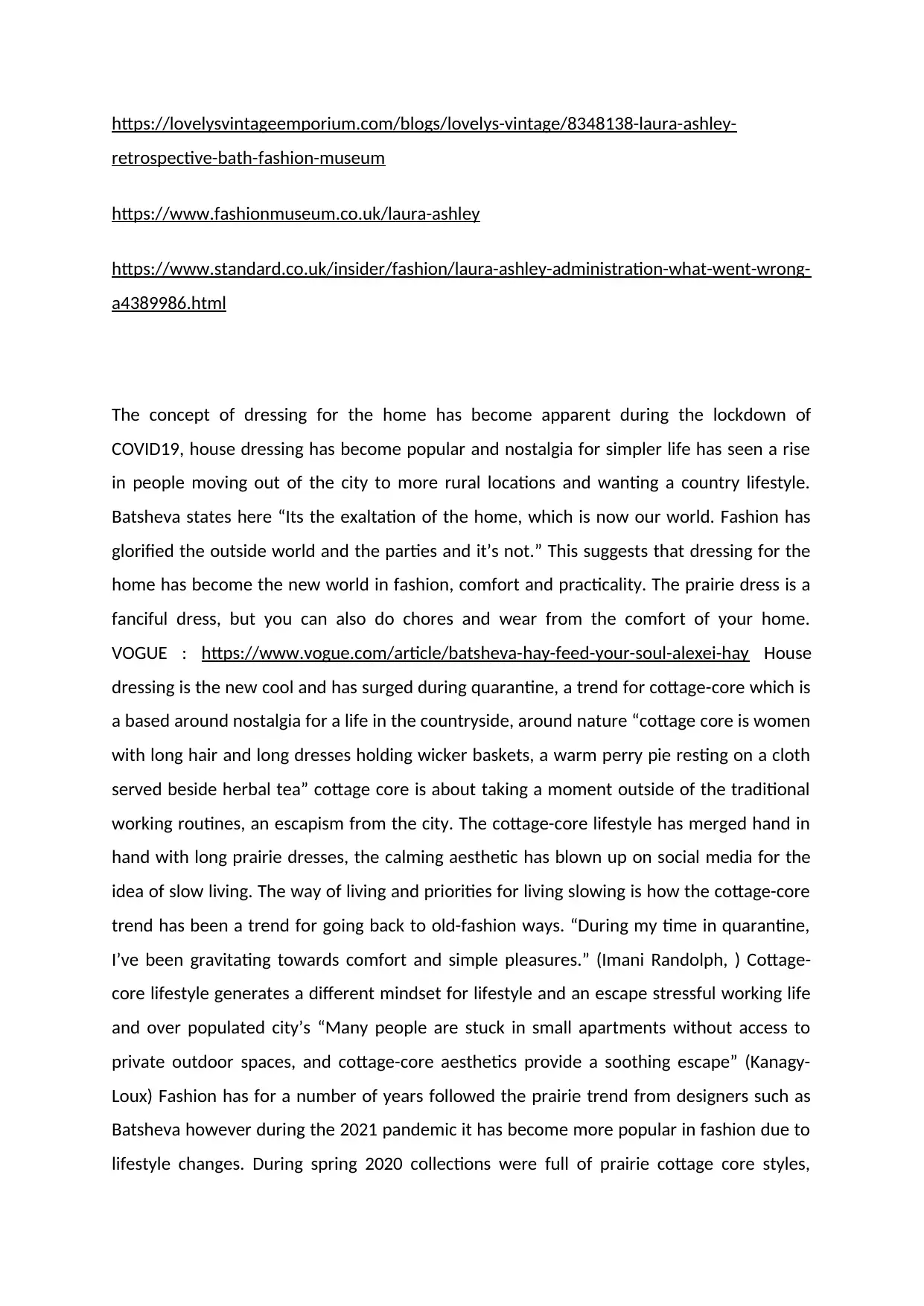
https://lovelysvintageemporium.com/blogs/lovelys-vintage/8348138-laura-ashley-
retrospective-bath-fashion-museum
https://www.fashionmuseum.co.uk/laura-ashley
https://www.standard.co.uk/insider/fashion/laura-ashley-administration-what-went-wrong-
a4389986.html
The concept of dressing for the home has become apparent during the lockdown of
COVID19, house dressing has become popular and nostalgia for simpler life has seen a rise
in people moving out of the city to more rural locations and wanting a country lifestyle.
Batsheva states here “Its the exaltation of the home, which is now our world. Fashion has
glorified the outside world and the parties and it’s not.” This suggests that dressing for the
home has become the new world in fashion, comfort and practicality. The prairie dress is a
fanciful dress, but you can also do chores and wear from the comfort of your home.
VOGUE : https://www.vogue.com/article/batsheva-hay-feed-your-soul-alexei-hay House
dressing is the new cool and has surged during quarantine, a trend for cottage-core which is
a based around nostalgia for a life in the countryside, around nature “cottage core is women
with long hair and long dresses holding wicker baskets, a warm perry pie resting on a cloth
served beside herbal tea” cottage core is about taking a moment outside of the traditional
working routines, an escapism from the city. The cottage-core lifestyle has merged hand in
hand with long prairie dresses, the calming aesthetic has blown up on social media for the
idea of slow living. The way of living and priorities for living slowing is how the cottage-core
trend has been a trend for going back to old-fashion ways. “During my time in quarantine,
I’ve been gravitating towards comfort and simple pleasures.” (Imani Randolph, ) Cottage-
core lifestyle generates a different mindset for lifestyle and an escape stressful working life
and over populated city’s “Many people are stuck in small apartments without access to
private outdoor spaces, and cottage-core aesthetics provide a soothing escape” (Kanagy-
Loux) Fashion has for a number of years followed the prairie trend from designers such as
Batsheva however during the 2021 pandemic it has become more popular in fashion due to
lifestyle changes. During spring 2020 collections were full of prairie cottage core styles,
retrospective-bath-fashion-museum
https://www.fashionmuseum.co.uk/laura-ashley
https://www.standard.co.uk/insider/fashion/laura-ashley-administration-what-went-wrong-
a4389986.html
The concept of dressing for the home has become apparent during the lockdown of
COVID19, house dressing has become popular and nostalgia for simpler life has seen a rise
in people moving out of the city to more rural locations and wanting a country lifestyle.
Batsheva states here “Its the exaltation of the home, which is now our world. Fashion has
glorified the outside world and the parties and it’s not.” This suggests that dressing for the
home has become the new world in fashion, comfort and practicality. The prairie dress is a
fanciful dress, but you can also do chores and wear from the comfort of your home.
VOGUE : https://www.vogue.com/article/batsheva-hay-feed-your-soul-alexei-hay House
dressing is the new cool and has surged during quarantine, a trend for cottage-core which is
a based around nostalgia for a life in the countryside, around nature “cottage core is women
with long hair and long dresses holding wicker baskets, a warm perry pie resting on a cloth
served beside herbal tea” cottage core is about taking a moment outside of the traditional
working routines, an escapism from the city. The cottage-core lifestyle has merged hand in
hand with long prairie dresses, the calming aesthetic has blown up on social media for the
idea of slow living. The way of living and priorities for living slowing is how the cottage-core
trend has been a trend for going back to old-fashion ways. “During my time in quarantine,
I’ve been gravitating towards comfort and simple pleasures.” (Imani Randolph, ) Cottage-
core lifestyle generates a different mindset for lifestyle and an escape stressful working life
and over populated city’s “Many people are stuck in small apartments without access to
private outdoor spaces, and cottage-core aesthetics provide a soothing escape” (Kanagy-
Loux) Fashion has for a number of years followed the prairie trend from designers such as
Batsheva however during the 2021 pandemic it has become more popular in fashion due to
lifestyle changes. During spring 2020 collections were full of prairie cottage core styles,
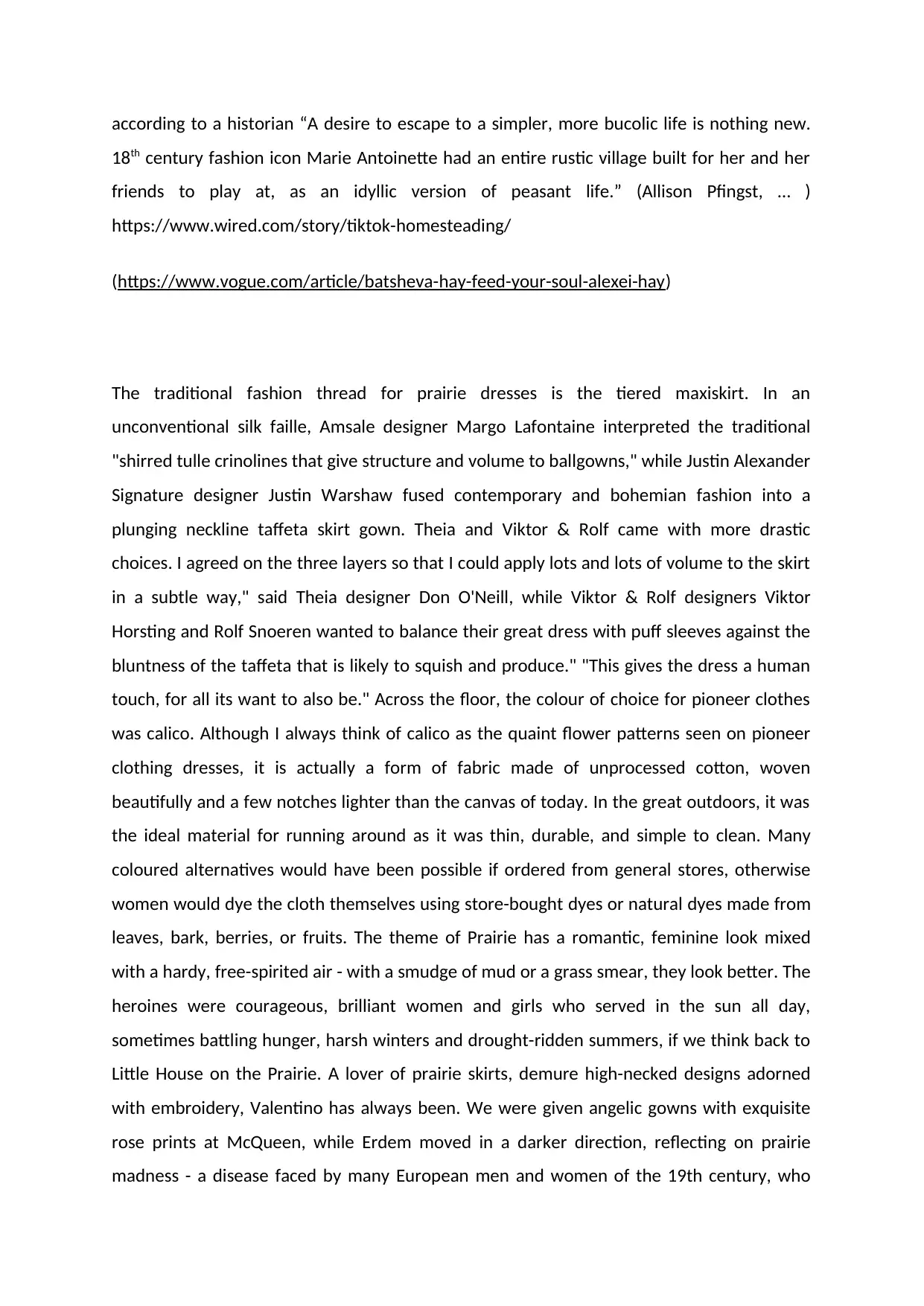
according to a historian “A desire to escape to a simpler, more bucolic life is nothing new.
18th century fashion icon Marie Antoinette had an entire rustic village built for her and her
friends to play at, as an idyllic version of peasant life.” (Allison Pfingst, … )
https://www.wired.com/story/tiktok-homesteading/
(https://www.vogue.com/article/batsheva-hay-feed-your-soul-alexei-hay)
The traditional fashion thread for prairie dresses is the tiered maxiskirt. In an
unconventional silk faille, Amsale designer Margo Lafontaine interpreted the traditional
"shirred tulle crinolines that give structure and volume to ballgowns," while Justin Alexander
Signature designer Justin Warshaw fused contemporary and bohemian fashion into a
plunging neckline taffeta skirt gown. Theia and Viktor & Rolf came with more drastic
choices. I agreed on the three layers so that I could apply lots and lots of volume to the skirt
in a subtle way," said Theia designer Don O'Neill, while Viktor & Rolf designers Viktor
Horsting and Rolf Snoeren wanted to balance their great dress with puff sleeves against the
bluntness of the taffeta that is likely to squish and produce." "This gives the dress a human
touch, for all its want to also be." Across the floor, the colour of choice for pioneer clothes
was calico. Although I always think of calico as the quaint flower patterns seen on pioneer
clothing dresses, it is actually a form of fabric made of unprocessed cotton, woven
beautifully and a few notches lighter than the canvas of today. In the great outdoors, it was
the ideal material for running around as it was thin, durable, and simple to clean. Many
coloured alternatives would have been possible if ordered from general stores, otherwise
women would dye the cloth themselves using store-bought dyes or natural dyes made from
leaves, bark, berries, or fruits. The theme of Prairie has a romantic, feminine look mixed
with a hardy, free-spirited air - with a smudge of mud or a grass smear, they look better. The
heroines were courageous, brilliant women and girls who served in the sun all day,
sometimes battling hunger, harsh winters and drought-ridden summers, if we think back to
Little House on the Prairie. A lover of prairie skirts, demure high-necked designs adorned
with embroidery, Valentino has always been. We were given angelic gowns with exquisite
rose prints at McQueen, while Erdem moved in a darker direction, reflecting on prairie
madness - a disease faced by many European men and women of the 19th century, who
18th century fashion icon Marie Antoinette had an entire rustic village built for her and her
friends to play at, as an idyllic version of peasant life.” (Allison Pfingst, … )
https://www.wired.com/story/tiktok-homesteading/
(https://www.vogue.com/article/batsheva-hay-feed-your-soul-alexei-hay)
The traditional fashion thread for prairie dresses is the tiered maxiskirt. In an
unconventional silk faille, Amsale designer Margo Lafontaine interpreted the traditional
"shirred tulle crinolines that give structure and volume to ballgowns," while Justin Alexander
Signature designer Justin Warshaw fused contemporary and bohemian fashion into a
plunging neckline taffeta skirt gown. Theia and Viktor & Rolf came with more drastic
choices. I agreed on the three layers so that I could apply lots and lots of volume to the skirt
in a subtle way," said Theia designer Don O'Neill, while Viktor & Rolf designers Viktor
Horsting and Rolf Snoeren wanted to balance their great dress with puff sleeves against the
bluntness of the taffeta that is likely to squish and produce." "This gives the dress a human
touch, for all its want to also be." Across the floor, the colour of choice for pioneer clothes
was calico. Although I always think of calico as the quaint flower patterns seen on pioneer
clothing dresses, it is actually a form of fabric made of unprocessed cotton, woven
beautifully and a few notches lighter than the canvas of today. In the great outdoors, it was
the ideal material for running around as it was thin, durable, and simple to clean. Many
coloured alternatives would have been possible if ordered from general stores, otherwise
women would dye the cloth themselves using store-bought dyes or natural dyes made from
leaves, bark, berries, or fruits. The theme of Prairie has a romantic, feminine look mixed
with a hardy, free-spirited air - with a smudge of mud or a grass smear, they look better. The
heroines were courageous, brilliant women and girls who served in the sun all day,
sometimes battling hunger, harsh winters and drought-ridden summers, if we think back to
Little House on the Prairie. A lover of prairie skirts, demure high-necked designs adorned
with embroidery, Valentino has always been. We were given angelic gowns with exquisite
rose prints at McQueen, while Erdem moved in a darker direction, reflecting on prairie
madness - a disease faced by many European men and women of the 19th century, who
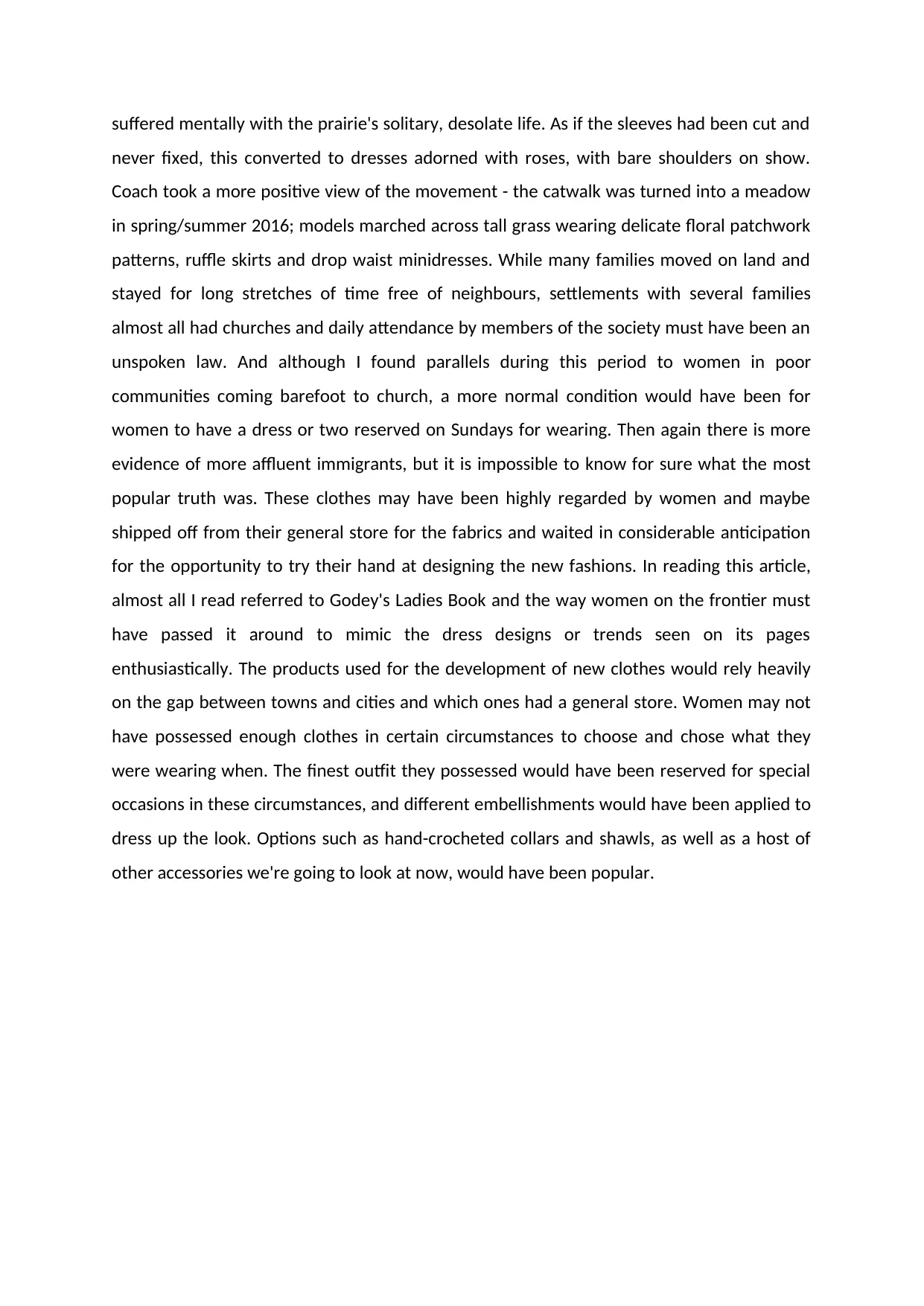
suffered mentally with the prairie's solitary, desolate life. As if the sleeves had been cut and
never fixed, this converted to dresses adorned with roses, with bare shoulders on show.
Coach took a more positive view of the movement - the catwalk was turned into a meadow
in spring/summer 2016; models marched across tall grass wearing delicate floral patchwork
patterns, ruffle skirts and drop waist minidresses. While many families moved on land and
stayed for long stretches of time free of neighbours, settlements with several families
almost all had churches and daily attendance by members of the society must have been an
unspoken law. And although I found parallels during this period to women in poor
communities coming barefoot to church, a more normal condition would have been for
women to have a dress or two reserved on Sundays for wearing. Then again there is more
evidence of more affluent immigrants, but it is impossible to know for sure what the most
popular truth was. These clothes may have been highly regarded by women and maybe
shipped off from their general store for the fabrics and waited in considerable anticipation
for the opportunity to try their hand at designing the new fashions. In reading this article,
almost all I read referred to Godey's Ladies Book and the way women on the frontier must
have passed it around to mimic the dress designs or trends seen on its pages
enthusiastically. The products used for the development of new clothes would rely heavily
on the gap between towns and cities and which ones had a general store. Women may not
have possessed enough clothes in certain circumstances to choose and chose what they
were wearing when. The finest outfit they possessed would have been reserved for special
occasions in these circumstances, and different embellishments would have been applied to
dress up the look. Options such as hand-crocheted collars and shawls, as well as a host of
other accessories we're going to look at now, would have been popular.
never fixed, this converted to dresses adorned with roses, with bare shoulders on show.
Coach took a more positive view of the movement - the catwalk was turned into a meadow
in spring/summer 2016; models marched across tall grass wearing delicate floral patchwork
patterns, ruffle skirts and drop waist minidresses. While many families moved on land and
stayed for long stretches of time free of neighbours, settlements with several families
almost all had churches and daily attendance by members of the society must have been an
unspoken law. And although I found parallels during this period to women in poor
communities coming barefoot to church, a more normal condition would have been for
women to have a dress or two reserved on Sundays for wearing. Then again there is more
evidence of more affluent immigrants, but it is impossible to know for sure what the most
popular truth was. These clothes may have been highly regarded by women and maybe
shipped off from their general store for the fabrics and waited in considerable anticipation
for the opportunity to try their hand at designing the new fashions. In reading this article,
almost all I read referred to Godey's Ladies Book and the way women on the frontier must
have passed it around to mimic the dress designs or trends seen on its pages
enthusiastically. The products used for the development of new clothes would rely heavily
on the gap between towns and cities and which ones had a general store. Women may not
have possessed enough clothes in certain circumstances to choose and chose what they
were wearing when. The finest outfit they possessed would have been reserved for special
occasions in these circumstances, and different embellishments would have been applied to
dress up the look. Options such as hand-crocheted collars and shawls, as well as a host of
other accessories we're going to look at now, would have been popular.
Secure Best Marks with AI Grader
Need help grading? Try our AI Grader for instant feedback on your assignments.
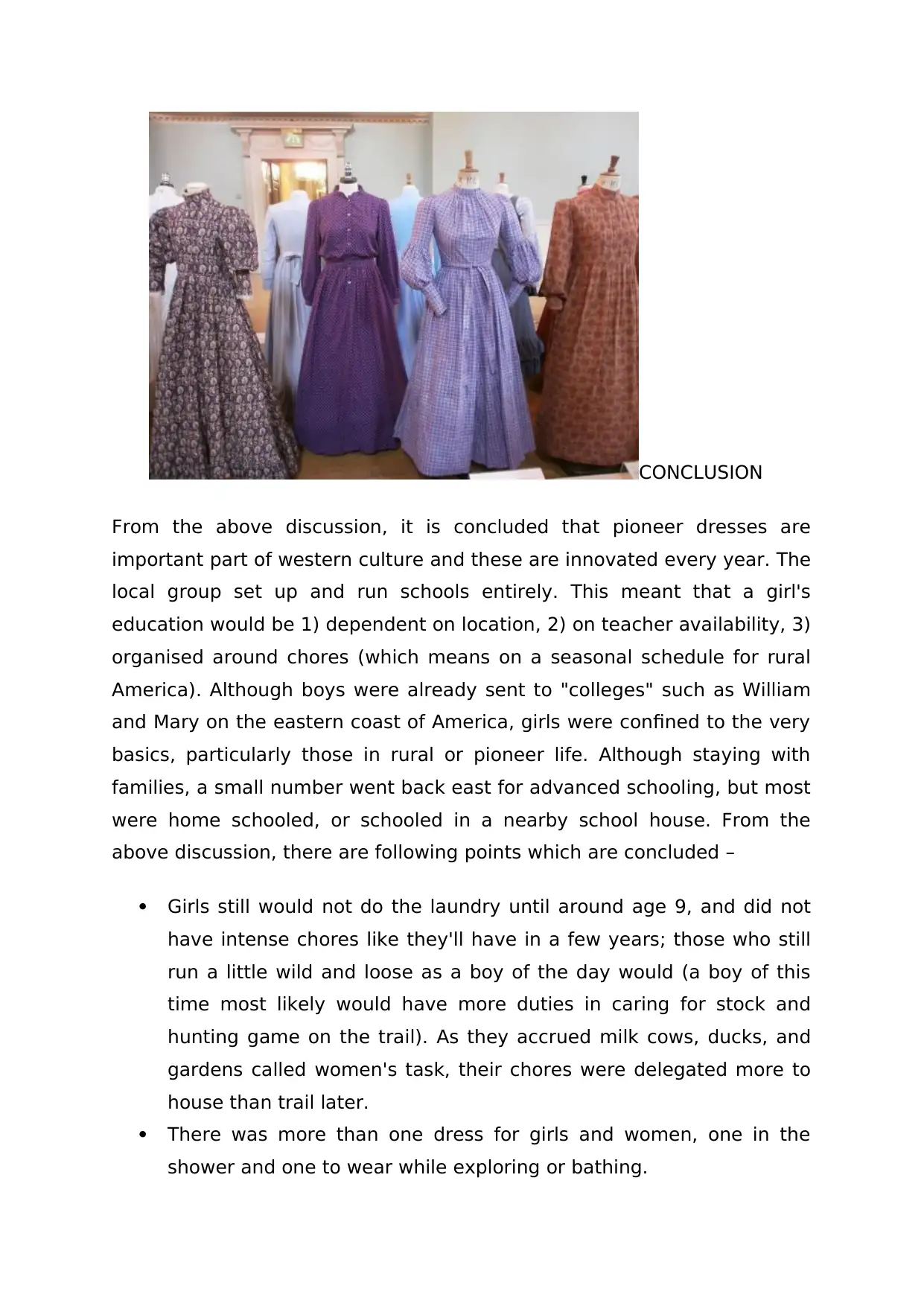
CONCLUSION
From the above discussion, it is concluded that pioneer dresses are
important part of western culture and these are innovated every year. The
local group set up and run schools entirely. This meant that a girl's
education would be 1) dependent on location, 2) on teacher availability, 3)
organised around chores (which means on a seasonal schedule for rural
America). Although boys were already sent to "colleges" such as William
and Mary on the eastern coast of America, girls were confined to the very
basics, particularly those in rural or pioneer life. Although staying with
families, a small number went back east for advanced schooling, but most
were home schooled, or schooled in a nearby school house. From the
above discussion, there are following points which are concluded –
Girls still would not do the laundry until around age 9, and did not
have intense chores like they'll have in a few years; those who still
run a little wild and loose as a boy of the day would (a boy of this
time most likely would have more duties in caring for stock and
hunting game on the trail). As they accrued milk cows, ducks, and
gardens called women's task, their chores were delegated more to
house than trail later.
There was more than one dress for girls and women, one in the
shower and one to wear while exploring or bathing.
From the above discussion, it is concluded that pioneer dresses are
important part of western culture and these are innovated every year. The
local group set up and run schools entirely. This meant that a girl's
education would be 1) dependent on location, 2) on teacher availability, 3)
organised around chores (which means on a seasonal schedule for rural
America). Although boys were already sent to "colleges" such as William
and Mary on the eastern coast of America, girls were confined to the very
basics, particularly those in rural or pioneer life. Although staying with
families, a small number went back east for advanced schooling, but most
were home schooled, or schooled in a nearby school house. From the
above discussion, there are following points which are concluded –
Girls still would not do the laundry until around age 9, and did not
have intense chores like they'll have in a few years; those who still
run a little wild and loose as a boy of the day would (a boy of this
time most likely would have more duties in caring for stock and
hunting game on the trail). As they accrued milk cows, ducks, and
gardens called women's task, their chores were delegated more to
house than trail later.
There was more than one dress for girls and women, one in the
shower and one to wear while exploring or bathing.
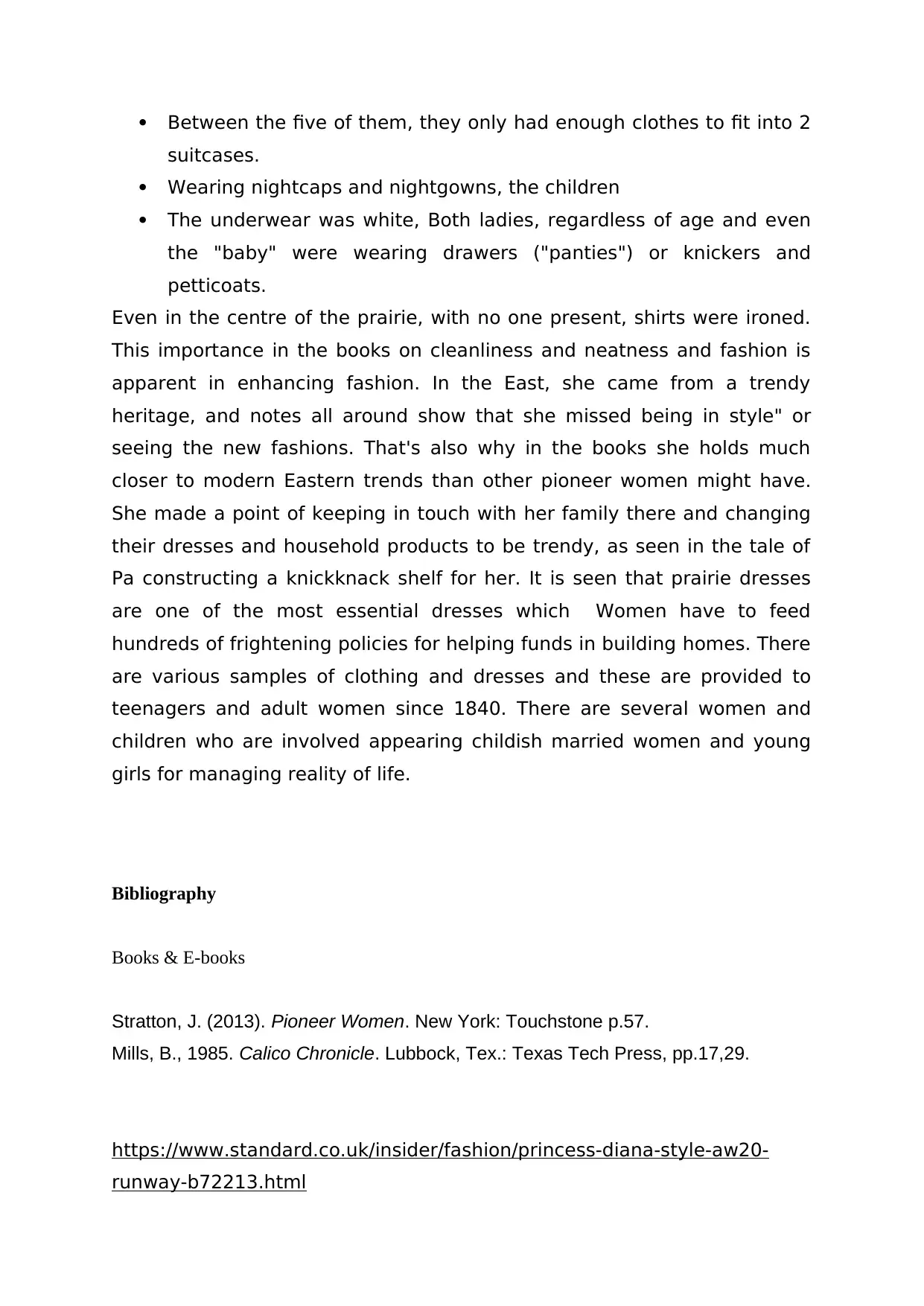
Between the five of them, they only had enough clothes to fit into 2
suitcases.
Wearing nightcaps and nightgowns, the children
The underwear was white, Both ladies, regardless of age and even
the "baby" were wearing drawers ("panties") or knickers and
petticoats.
Even in the centre of the prairie, with no one present, shirts were ironed.
This importance in the books on cleanliness and neatness and fashion is
apparent in enhancing fashion. In the East, she came from a trendy
heritage, and notes all around show that she missed being in style" or
seeing the new fashions. That's also why in the books she holds much
closer to modern Eastern trends than other pioneer women might have.
She made a point of keeping in touch with her family there and changing
their dresses and household products to be trendy, as seen in the tale of
Pa constructing a knickknack shelf for her. It is seen that prairie dresses
are one of the most essential dresses which Women have to feed
hundreds of frightening policies for helping funds in building homes. There
are various samples of clothing and dresses and these are provided to
teenagers and adult women since 1840. There are several women and
children who are involved appearing childish married women and young
girls for managing reality of life.
Bibliography
Books & E-books
Stratton, J. (2013). Pioneer Women. New York: Touchstone p.57.
Mills, B., 1985. Calico Chronicle. Lubbock, Tex.: Texas Tech Press, pp.17,29.
https://www.standard.co.uk/insider/fashion/princess-diana-style-aw20-
runway-b72213.html
suitcases.
Wearing nightcaps and nightgowns, the children
The underwear was white, Both ladies, regardless of age and even
the "baby" were wearing drawers ("panties") or knickers and
petticoats.
Even in the centre of the prairie, with no one present, shirts were ironed.
This importance in the books on cleanliness and neatness and fashion is
apparent in enhancing fashion. In the East, she came from a trendy
heritage, and notes all around show that she missed being in style" or
seeing the new fashions. That's also why in the books she holds much
closer to modern Eastern trends than other pioneer women might have.
She made a point of keeping in touch with her family there and changing
their dresses and household products to be trendy, as seen in the tale of
Pa constructing a knickknack shelf for her. It is seen that prairie dresses
are one of the most essential dresses which Women have to feed
hundreds of frightening policies for helping funds in building homes. There
are various samples of clothing and dresses and these are provided to
teenagers and adult women since 1840. There are several women and
children who are involved appearing childish married women and young
girls for managing reality of life.
Bibliography
Books & E-books
Stratton, J. (2013). Pioneer Women. New York: Touchstone p.57.
Mills, B., 1985. Calico Chronicle. Lubbock, Tex.: Texas Tech Press, pp.17,29.
https://www.standard.co.uk/insider/fashion/princess-diana-style-aw20-
runway-b72213.html

1 out of 25
Your All-in-One AI-Powered Toolkit for Academic Success.
+13062052269
info@desklib.com
Available 24*7 on WhatsApp / Email
![[object Object]](/_next/static/media/star-bottom.7253800d.svg)
Unlock your academic potential
© 2024 | Zucol Services PVT LTD | All rights reserved.

